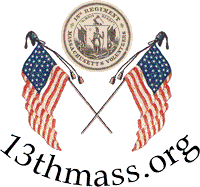Prologue;
Sarah Broadhead's
Diary - July
2nd
"Diary
of a Lady of Gettysburg, Pennsylvania from
June 15 to July 15,
1863.
By Sarah M. Broadhead.
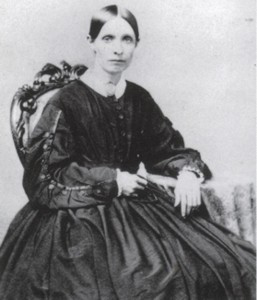
July
2. — Of
course we had no rest last
night.
Part of the time we watched the Rebels rob the house
opposite.
The family had left some time during the day, and the robbers must have
gotten all they left in the house. They went from the garret
to
the cellar, and loading up the plunder in a large four-horse wagon,
drove it off. I expected every minute that they would burst
in
our door, but they did not come near us. It was a beautiful
moonlight night, and we could see all they did.
July
2. — The
cannonading commenced about 10
o'clock,
and we went to the cellar and remained a little while until it
ceased. When the noise subsided, we came to the light again,
and
tried to get something to eat. My husband went to the garden
and
picked a mess of beans, though stray firing was going on all the time,
and bullets from sharpshooters or others whizzed about his head in a
way I would not have liked. He persevered until he picked
all,
for he declared the Rebels should not have one. I baked a pan
of
shortcake and boiled a piece of ham, the last we had in the house, and
some neighbors coming in, joined us, and we had the first quiet meal
since the contest began. I enjoyed it very much. It
seemed
so nice after so much confusion to have a little quiet once
more.
We had not felt like eating before, being worried by danger and
excitement. The quiet did not last long.

About
4 o'clock P.M. the storm burst again with
terrific
violence. It seemed as though heaven and earth were being
rolled
together. For better security we went to the house of a
neighbor
and occupied the cellar, by far the most comfortable part of the
house. Whilst there a shell struck the house, but mercifully
did
not burst, but remained imbedded in the wall, one half
protruding. About 6 o'clock the cannonading lessened, and we,
thinking the fighting for the day was over, came out. Then
the
noise of the musketry was loud and constant, and made us feel quite as
bad as the cannonading, though it seemed to me less
terrible. Very soon the artillery joined in the din,
and soon
became as awful as
ever, and we again retreated to our friend's underground apartment, and
remained until the battle ceased, about 10 o'clock at night.
I
have just finished washing a few pieces for my child, for we expect to
be compelled to leave town tomorrow, as the Rebels say it will most
likely be shelled.
I cannot sleep, and as I sit down to write, to
while
away the time, my husband sleeps as soundly as though nothing was
wrong. I wish I could rest so easily, but it is out of the question for
me either to eat or sleep under such terrible excitement and such
painful suspense. We know not what the morrow will bring
forth,
and cannot even tell the issue of to-day. We can gain no
information from the Rebels, and are shut off from all communication
with our soldiers. I think little has been gained by either
side
so far. Has our army been sufficiently reinforced?
is our
anxious question. A few minutes since we had a talk with an
officer of the staff of General Early, and he admits that our army has
the best position, but says we cannot hold it much longer.
The
Rebels do so much bragging that we do not know how much to
believe. At all events, the manner in which this officer
spoke
indicates that our troops have the advantage so far. Can they
keep it? The fear they may not be able causes our anxiety and
keeps us in suspense.
Has our army been sufficiently reinforced?
is our
anxious question. A few minutes since we had a talk with an
officer of the staff of General Early, and he admits that our army has
the best position, but says we cannot hold it much longer.
The
Rebels do so much bragging that we do not know how much to
believe. At all events, the manner in which this officer
spoke
indicates that our troops have the advantage so far. Can they
keep it? The fear they may not be able causes our anxiety and
keeps us in suspense.
This photograph
was copied from the website "Gettysburg Daily." It
is believed the Joseph
Broadhead Family was living at 217 Chambersburg Street,
pictured on the right. The grey building next door, is the
David Troxell House. During the afternoon artillery duel,
Troxell's neighbors, including Sarah and her husband, gathered in the
basement of this home for safety. A shell struck the Troxell
house,
which can still be seen today. "This view was taken facing
northwest at approximately
2:00
PM on Thursday, January 1, 2009."
Return
To Table of Contents
Introduction
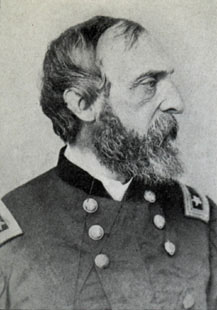
While
the battle raged at Gettysburg, July 1st, Commanding
General George
G. Meade remained at Army Headquarters in
Taneytown, Maryland, to direct the concentration of the rest of
the army at Gettysburg. He sent trusted subordinate,
General
Winfield
Scott Hancock to the battle-field in his stead, to take
command of
the troops, monitor the day’s events, and report back to
headquarters whether or not the ground there was favorable for a
battle. But in the afternoon, before
hearing directly from Hancock, and once he was
convinced that
the enemy, General Robert E. Lee, was bringing his whole force to
Gettysburg, General Meade issued
orders to his several corps commanders to do the same.
In just 4 days, upon assuming command of the Army of the
Potomac, Meade
had gathered information, maneuvered the great scattered Army of the
Potomac north, and planned
for various contingencies depending on the enemy’s moves. A
tremendous accomplishment. Now
a great battle was imminent.
He remained at the Taneytown headquarters until
midnight, hoping to
meet with General
Sedgwick of the 6th Corps before departing, but delayed no
longer. He
had to get to Gettysburg 12 miles away, and prepare for the next days
fight.
He rode up to the Evergreen Cemetery gatehouse on
Cemetery Ridge about
1 a.m. and was greeted by several of his generals with favorable
news. This was a good place to fight.
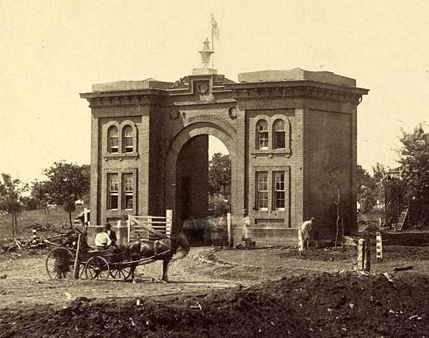
He was glad to hear that for “it was too late to
leave it.” 1
General Meade spent the rest
of the night, until early morning, riding the lines of his army,
accompanied by a staff engineer who mapped the terrain and noted the
commanding general’s intended troop placements. Chief of 1st
Corps Artillery, Colonel Charles Wainwright recorded in his
journal:
"General
Meade came along our line between one and two o'clock this morning.
General Hunt was with him, and I explained to him, as well as
I
could, the dispositions I had made here. It was not light
enough
to see much and they did not stop long."
Meade worried
that the enemy would attack before all was ready. He needed
day light to properly maneuver his several arriving army corps into
battle
positions.
Initially General Meade’s idea was to make a
strong attack on
the Confederates’ left flank from the area around Culp’s
Hill. In the morning he sent his chief engineer, General G.
K.
Warren off to examine the ground and report whether such an
attack
would be favorable. Then, he sent his son, George, as Aide,
to
check
on the 3rd Corps deployment at the left of the Union line. It
was the only corps that had not yet reported to headquarters.
As fate would have it, the fortunes of the Federal Army on July 2nd,
derived from the actions of 3rd Corps Commander, Major-General Daniel
E. Sickles.
General Sickles reported to General Meade’s son that he
was unaware, of
where precisely he was to deploy his troops. A quick
round-trip ride back to Headquarters, and the general’s son quoted
Meade’s instructions for General Sickles. “The Third Corps
was to go on the left of the Second Corps and prolong its line to
Geary’s position of the night before. (Little Round Top).
This was to be done as rapidly as possible.” 2

But, General Sickles was not happy with the ground
General Meade
assigned the 3rd Corps. That morning, he had agreed with one
of his aides that the high ground near the Emmitsburg Road was
preferable. Sickles rode to headquarters about 10 a.m., and
voiced his concerns. He requested General Meade accompany him
to examine the preferred ground. Meade refused being too
busy, but gave permission for his Chief of Artillery General Henry Hunt
to go. Before riding off, Sickles asked Meade if he could
place his troops where he saw fit. Meade replied, “Certainly,
within the limits of the general instructions I have given
you; any ground within those limits you choose to occupy, I leave to
you.,” 3
Major-General
Daniel Sickles, pictured.
The Chief of Artillery saw some advantages to the
advanced position
that Sickles wanted to occupy, but he also saw its fatal flaw, it was
twice as much ground to hold as that which was assigned, and it would
take many more men than Sickles had to hold it.
Hunt gave Sickles some suggestions as to where artillery might be
placed if the forward line was utilized, then left to tend to
his
own matters. On the way to Cemetery Hill Hunt stopped at
Headquarters and reported to Meade that Sickles' position ‘taken on its
own’ was strong, but that Meade should see it for
himself. 4
As morning gave way to mid-day, a continuing series of
miscarried communications between his own staff and head-quarters
irritated
General
Sickles. He believed his line was a better one to fight off
an enemy attack, and that head-quarters was ambivalent to the concerns
of the 3rd Corps and its commander.
When skirmishing broke out in the woods opposite his
favored position
about 1 p.m. Sickles abandoned Meade's intended line and decided to
advance his troops ¾ mile, to the high
ground on the Emmitsburg Road near the Sherfy family Peach Orchard.
The new 3rd Corps line over extended itself. It
covered too
much ground. It had gaps. It was made without the
knowledge of the troops that connected on the right, and it
severed that
connection. When General
Meade, who was not known for his mild temper, finally learned what had
happened, he blew a gasket, so to speak. An aide wrote, "I
have
never seen him so angry." Meade rode to General
Sickles'
line and
correctly observed, it could not be held by the 3rd Corps
alone. Sickles agreed, but continued to assert that in his
opinion it was the best line. An Aide to General Meade remembers his
answer to Sickles as, “General Sickles, this is neutral ground, our
guns command it as well as the enemy’s. The very reason you
cannot hold it applies to them.” 5
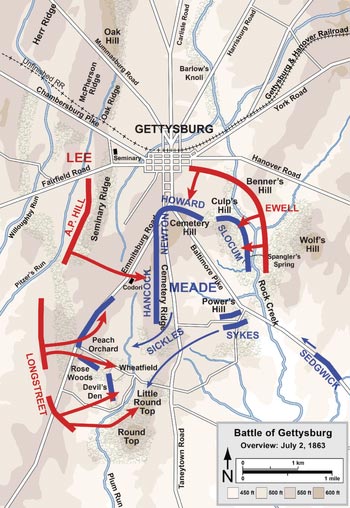
General Sickles
was ordered to anchor his line at the Round Tops and connect with
General Hancock's line on Cemetery Ridge. The map at left
shows the advanced line that General Sickles took up
without General Meade's knowledge. Consequently
General Meade had to rush troops onto the field to bolster Sickles'
vulnerable position. (Ewell's attack as depicted occured in
the evening.) The map is by Hal Jesperson,
www.posix.com/CW; from Wikimedia Commons.
Hearing this, General Sickles offered to return to the
ground first
specified. But the boom of enemy cannon announced it was too
late.6 It was after 3
p.m. The fight was about to begin.
The rest of the afternoon, during the course of intense
fighting on the 3rd Corps front, General Meade desperately shovelled
troops from the 2nd and 5th Corps into the battle ground chosen by
General Sickles.
If General Meade’s staff was negligent for not directing
Sickles into
position, Sickles advance was insubordinate. Fortunately for
General Meade, things weren't proceeding smoothly for those people
across the lines.
The Confederate Army had its own problems with planning
and deployment
on the morning of July 2nd. General Robert E. Lee’s planned
assault on the
Union left was based upon a deeply flawed reconnaissance report done
very early in the morning. Once begun, the
attack
had to be altered on the battlefield. General James
Longstreet, whose corps was to do the fighting, was against making the
attack at all. He considered the Union defenses too strong to
break. Confusion and poor supervision delayed the deployment
of Longstreet’s troops as they moved south into battle
position. The hours of the day passed away. It took
six hours before the planned Confederate attack began. But
once
underway, the
Rebels pushed hard and soon broke
General Sickles’s salient at the Sherfy Peach Orchard along Emmitsburg
Road. The rest of the 3rd Corps line eventually collapsed. In
spite of
success, the Rebel attack sputtered out as darkness fell.
For, after the tired but victorious Confederate troops swept the
Federals from the ground Sickles occupied, they faced another Union
line in a strong position along Cemetery Ridge. It was the
line
General
Sickles had initially been ordered to hold by General Meade.
It
was General Meade and his able subordinates who patched the new
defensive line
together, and saved the day for the Federals.
In the evening, another crisis would emerge to the
north, on the right
of the Union lines at Culp’s Hill, but more on that later.
NOTES
1. Coddington, Edwin
B., "Gettysburg
Campaign, A Study in Command", First Touchstone Edition,
1997; p. 323. Author Coddington cites: General
O.O. Howard for this comment, OR, XXVII, pt. 1, p. 705.
2. Pfanz, Harry W.,
"Gettysburg, The
Second Day, The University of North Carolina Press", 1987; p. 83.
Author Pfanz cites "Meade, Life and Letters of George Gordon
Meade," 2 vols. New York: Charles Scribner's Sons, 1913. p. 67;
Meade, "With Meade at Gettysburg," Philadelphia: John C.
Winston Company, 1930. p. 101; Meade Testimony, "Committee on
the Conduct of the War", p. 338.
3. Pfanz, p. 93.
Author Pfanz
cites: "With Meade at Gettysburg", p. 106; Meade Testimony, "CCW
Report", p. 328;
Sickles' Testimony , "CCW", p. 298.
4. Coddington, p.
345. Author Coddington
cites: CCW Report, vol. 1, p. 449-451.
5. Pfanz, p. 144.
Author Pfanz cites:
Major James C. Biddle to Meade, 18 Aug. 1880, Gettysburg Letter Book.
George Gordon Meade Collection, The Historical Society of Pennsylvania.
Philadelphia, Pennsylvania, p. 27; Meade, "With Meade at Gettysburg",
p. 114.
6. Meade at Gettysburg etc.
Return
to Table of Contents
What's
On This Page
This Gettysburg page was another difficult page to
assemble. Not too much source
material exists from the 13th Mass., and that which exists is a bit
vague in
terms of battle-field deployments. Once again, the problem
was solved by looking beyond the regimental resources for information.
The page begins with a
citizen's perspective of the battle;-- Sarah Broadhead's prologue.
It is followed by a brief introduction that sets the stage
for the day's battle by looking at the controversy of General Sickles'
3rd
Corps deployment.
Then, an analysis of men and losses in Robinson's division
from the first day's fight is presented to show how depleted these
regiments were on July 2nd. The 13th Mass., now numbered
about 98 men, present for duty, down from 284 that entered the
battle. Following this is a brief look at the new
First
Corps Commander, Major-General John Newton. Newton's life
&
career up to the time of his appointment is summarized in the
section titled, 'A New Corps
Commander.' And then comes some stories from the 13th Mass.
The
section titled 'Battle Impressions of 3
Soldiers', presents some brief reflections from Sam Webster,
David
Sloss and William R. Warner on
the first days battle. Each account is short but considering
how few men of the regiment actually made it to Cemetery Hill to
participate in the battle on the 2nd and 3rd days, I am grateful to
have them. Lieutenant Warner made a list of Company K men
present at Gettysburg. I must thank Warner's
step-descendant Eric Locher for allowing me to use this excerpt of
Warner's manuscript on my website. The Gettysburg pages are
infinitely stronger in content because of it. Another
highlight of this section is the 1911 photograph of survivors of
Company K, taken from William Warner's scrapbook. Warner's scrapbook
came up for sale at an auction house in the fall of 2015, and
I was fortunate to get a good copy of this image. The page
continues with some excerpts from the writings of Major Abner Small.

Major Abner Small, was a lieutenant in
the 16th Maine at the time of the battle. This regiment,
somewhat of a 'hard luck' unit, served in the same brigade with the
13th Mass, for a long time. The fortunes of the two units
were often intertwined. And, Major Small's descriptive
narrative is exquisite. He was ordered to serve as Adjutant
for Colonel Richard Coulter of the 11th PA, who transferred out of
Baxter's 2nd Brigade to take command of Paul's
1st Brigade. Major Small gives some amusing insights into
Coulter's character. After the introduction to Colonel
Coulter the narrative for July 2nd, from the 13th
Mass., regimental history is given.
Charles Davis, Jr., borrowed heavily from William
Warner's diary for the brief
passage about July 2nd, so I include Warner's diary entries to begin
with. But,
both accounts are vague and I would say that Davis's brief statements
are
downright confusing for someone trying to track the
regiment's positions on the field of battle this day. To
remedy this, a series of hourly maps from battle-field historian John
B. Bachelder (1825-1894), are presented in the section, 'So, Where
exactly Were They on
July 2nd?' The maps show the specific locations
of
Robinson's division during the day, as recorded by Bachelder.
The essay also discusses
in general terms, the progress of the battle and why the
regiment/division was
moved around so much.

This
image shows the position held by
Paul's (Coulter's) Brigade the night of July 1st until the
morning
of July 2nd. Part of the brigade was out front at the blue
line.
The rest formed along the wall in the foreground, up to the
Bryan
house and barn, seen in the first picture. This was
the view the boys had when they awakened on the morning July
2nd, surrounded by troops of the 2nd Army Corps. It also
happens to be
the point on the Federal line reached by Rebel soldiers in Pickett's
Charge on July 3rd. Notice the Codori barn along
the Emmitsburg Road in the background. That is the place
where
the regiment
had turned from the road and rushed over the fields towards the
Seminary on the morning of July 1st. Click to
view larger.

The page changes gear for the final articles.
The interesting narratives of Private Bourne
Spooner and Sergeant Austin Stearns describe their different
experiences as
prisoners of war. Spooner is corralled with the rest of
the Union Army captives, but Stearns, is wounded, and so remained at
Christ
Church Hospital on Chambersburg Street. He was free to ramble
about the town within limits, and describes his wanderings and
encounters with Rebel soldiers. After looking in on the
prisoners, the narrative turns back to head-quarters with the section
titled, 'Council of War.' This is a follow up to the
introduction, with a look at Meade's gathering of Corps Commanders
following the heavy fighting of July 2nd. The article is
written
by one of the participants, Brigadier-General John Gibbon of the 2nd
Corps.
After this, the page
concludes with a
short story "Lost Among the Dead" found in Bivouac Magazine, 1885.
It is a fictionalized account of a soldiers
experience based on the real experiences of author G.F. Williams, who
was both a soldier and a war correspondent. The story
reinforces the idea, often lost amid stories of valor, that this war
was in fact a horrible thing. -- I hope you will enjoy this
page.
PICTURE CREDITS:
All images & Maps are from
the Library of
Congress digital images collection, with the following
exceptions: Sarah Broadhead is from the blog, "In The Swan's
Shadow",
http://theebonswan.blogspot.com/2013/06/sarah-broadheads-battle-narrative-of.html;
The
David Troxell House from Gettysburg Daily,
http://www.gettysburgdaily.com/gettysburgs-david-troxell-house-artillery-shell/;
Cemetery
Gate House, & battle-field dead, (Sepia photos by Timothy
O'Sullivan) from the Chrysler Museum of Art, Digital Photograph
Collection; Gettysburg Battle Map,
July 2nd by Hal Jesperson, accessed by Wikimedia Commons.
Portrait of David Sloss was shared with me by Mr. Scott
Hann; Charles Reed sketch of canteen burdoned soldier accessed
digitally from "Hard Tack & Coffee," by John D. Billings;
accessed digitally via google books. Major Abner R.
Small, 16th
Maine, from
"Road To Richmond" edited by Harold A. Small, University of
California Press, Berkeley, California, 1939; Frank Schell's
sketch of an exploding
shell and John Allen Maxwell's sketch of a Rebel Soldier (in Austin
Stearns section) from Civil War Times Illustrated;
Copies
of the
Bachelder Maps are from Mr. Bob George and Mr. Steven Floyd of
Gettysburg; Evening photographs by Buddy Secor, his pseudonym
'Ninja Pix" used with permission. Other snapshots of the
battlefield were taken by Susan Z. Forbush, June, 2016;
Sergeant
Bourne Spooner presented by his
descendant, Mr. Will Glenn;
"Louisiana Pelican' by artist A.C.Redwood, & Edwin Forbes
sketch,
'Confederate Attack on Cemetery Hill,' from Battles &
Leaders of the Civil
War, Century Publications, 1887-1888; Portrait of John Flye
and Dan Warren, from author's private collection;
Charles Reed sketch of soldiers sharing a canteen from the
New York Public Library digital collections; ALL IMAGES HAVE BEEN
EDITED IN PHOTOSHOP.
Return
to Table of Contents
Robinson's
Division;
Strengths & Losses

The first day's fight at Gettysburg was looked
upon
as a Union defeat, although the First Corps troops fought
brilliantly
against a superior force of the enemy and gained time for the Union
Army to consolidate at Cemetery Hill. It was a delaying
action. Though they took a
licking, the First Corps soldiers never considered themselves
whipped. Their comrades in the army also knew that they had
fought
well. In fact, as Charles E. Davis, Jr. wrote of the first
day’s battle, “We saw at once that we had stayed at the front
a little
too long for our safety. Some of us were to be gobbled and
sent to rot in rebel prisons. Over fences, into yards,
through gates, anywhere an opening appeared, we rushed with all our
speed to escape capture.” First corps losses figure about
49.6 % in killed wounded and missing men.
General Robinson's 2nd Division suffered a loss of
56.4% in men
killed, wounded, captured or missing. The loss in
captured
or missing men from
Robinson’s Division accounted for over half these numbers.
Eleventh Corps casualties by comparison, were
lower. Once again like at the battle of Chancellorseville,
this unlucky corps was caught in an
indefensible position, and hit hard on the flanks by a superior enemy
force. And, like
at the Battle of Chancellorsville, it was abruptly compelled to leave
the field. Because the majority of troops in the 11th Corps
were of German ancestry, it earned the unwelcome sobriquet of
“The
Flying Dutchmen.” It would have to suffer its bad reputation
a while longer. As the tattered remnants of the First and
Eleventh Corps scrambled on to Cemetery Hill, in the late afternoon
hours of
July 1, an officer directing the troops into their new
respective positions was heard to say, “First Corps goes to the right
and Eleventh
Corps go to hell.”1
In Consequence, of the heavy losses racked up in
the first day's battle, the shattered troops of the First Corps, were
held in reserve during the 2nd and 3rd days' fighting.
Union losses for the day, were dutifully reported
at the
regimental level, though
they were done so with, not
unexpected errors. From these reports,
brigade
and division losses could be generally determined. But unit
strengths going into the battle at the regmental and brigade
level
are a trickier thing to tabulate. In order to give an idea
of First Corps' losses, and those of General Robinson's
2nd Division, a few
sample tallies are hereby presented.
Numbers,
Numbers, Numbers
Official
Reports for the battle give army strengths at corps and division
levels. It is more difficult to determine unit strengths at
the
smaller brigade and regimental level.

Several
attempts to determine division and brigade strengths at the Battle of
Gettysburg have been made over the years. General John
Robinson
himself,
reported his division went into battle with 'less than 2,500 men, and
lost 1,667 in killed, wounded and missing.' As time passed,
others
took pains to compute the actual numbers of men engaged in the great
battle.
Among these are John Mitchell Vanderslice, an
Executive Board Member of the Gettysburg Battlefield Memorial
Association. The Association formed in 1864, dedicated to
preserving the historic battle-ground and its legacy for future
generations. In 1895, Vanderslice was chosen by the Board of
Directors of the association to write a concise history of the battle
due to the knowledge he gained working with veterans on the GBMA
monument commission.2
In his work, Vanderslice admitted that the numbers
reported during the battle were inaccurate, but in many
instances
corrections were made to the battle-field monuments, within certain
restrictions. The following chart includes numbers taken from
the monuments. Other sources used in the chart below include
Century Publications historic work "Battles & Leaders of the
Civil War," 1884-1887. And, John Vautier's work, "A
Discursive Chapter on the First Day at Gettysburg", a careful study of
the battle that is included within the regimental history of the 88th
PVI.3
In more recent times, historians David
G. Martin with John W. Busey attempted a serious analysis of the data
and came
up with their own numbers. The 'Busey & Martin'
numbers presented here were printed
in Steven A. Floyd's book, "Commanders and
Casualties at the Battle of Gettysburg."
The
following charts are presented to give a general idea of the numbers
and losses of Robinson's Division and to show the discrepancies in a
select sampling of source material.
Robinson's
Division; Strength & Losses
| Source |
Strength |
Killed |
Wounded |
Missing |
Total
Losses |
| General
Robinson's Report |
2,500 |
x |
x |
x |
1,667 |
| Busey
& Martin 2005 ed. |
2,995 |
91 |
616 |
983 |
1,690 |
| Battles
& Leaders of the CW |
x |
90 |
613 |
933 |
1,681 |
| John
M. Vanderslice |
3,248 |
707
k/w |
982 |
1,629 |
| Gettysburg
Monuments |
3,133 |
116 |
592 |
972 |
1,680 |
| John
Vautier |
2,764 |
x |
x |
x |
1,525 |
I've compiled data to make the following charts
which show
the discrepancies in regimental strengths as recorded in a variety of
sources. The source list is provided below the charts.
General Paul's 1st
Brigade,
Regimental Strength;
| Regiment |
O.R. |
Vanderslice |
State
Commissions |
Regimental
History |
Monument |
Busey
& Martin |
| 16
ME |
x |
298 |
30/350* |
25/267 |
25/250 |
298 |
| 13
MA |
260 |
x |
x |
284 |
284 |
284 |
| 94
NY |
x |
x |
30/415 |
x |
445 |
411 |
| 104
NY |
x |
x |
330 |
x |
309 |
285 |
| 107
PA |
25/230 |
255 |
25/230 |
x |
25/230 |
255 |
| Totals |
x |
x |
x |
x |
1,568** |
1536*** |
General
Baxter's 2nd Brigade, Regimental Strength;
I could not find any
mention of unit strength for any of Baxter's regiments in the O.R.
| Regiment |
O.R. |
Vanderslice |
State
Commissions |
Regimental
History |
Monument |
Busey
& Martin |
| 12
MA |
x |
x |
x |
about
200 |
301 |
261 |
| 83
NY |
x |
x |
215 |
less
than 200 |
215 |
199 |
| 97
NY |
x |
x |
255 |
24
officers/? men |
255 |
236 |
| 11
PA |
x |
292 |
292 |
212 |
23/269 |
270 |
| 88
PA |
x |
296 |
296 |
less
than 300 |
294 |
273 |
| 90
PA |
x |
208 |
208 |
208 |
208 |
208 |
| Totals |
|
|
|
|
1,565 |
1,451*** |
The
13th Massachusetts Volunteer Infantry
Charles
Davis, Jr. wrote in the regimental history of the 13th Mass., "Of the
two hundred and eighty-four men and officers
we took into the fight, only ninety-nine now remained for duty, the
casualties being seven killed and eighty wounded, a total of
eighty-seven. In addition to this number ninety-eight men
were
taken prisoners on their way back through the town."
*In Maine
at Gettysburg, Major Abner Small writes, "It will be
observed
that the list above given presents a total of 100 more men and six more
officers than the numbers given respectively in the inscription on the
monuments. ...in regard to the officers...those of the field
and
staff were inadvertantly omitted in making up the account for the
inscription" Major Small says that one of the six officers on
staff was
absent sick. He continued, "With regard to the discrepancy in the
two reports of men present, ...the numbers given in the inscription are
those reporting present for duty at the last roll-call before the
battle. It is certain that men came up at some time during
the
three days battle. But it is believed to be more nearly just
to... [include] ...some who were not in the battle than to leave off
some because there is no other proof of their being present..."
**Mostly
on the First Day.
***The
Totals add up to 1,533 for Paul & 1,447 for Baxter. 3
& 4
extra officers and men respectively, on staff and command, are added to
the totals.
SOURCES:
Official
Records of the War of the Rebellion, Vol. 27. Part 1;
p. 289-312.
Gettysburg
Then and Now, by John M. Vanderslice, A
Director of the Memorial Association, New York, G.W. Dillingham Co.,
Publishers; 1899; p. 124.
State
Commissions: Maine
at Gettysburg, Report of Maine Commissioners
prepared by the Executive
Committee, 1898; p. 42, & 51-58. New
York Monuments Commission for the Battlefields of Gettysburg and
Chattanooga. Final Report On The Battlefield of Gettysburg, Albany, J.B. Lyon
Company, Printers 1900, Vol. 1., p. 108. Pennsylvania at
Gettysburg, Pennsylvania Battle-field Commission, 1914, Vol. 1, p.
172-173.
Regimental
Histories: The
Sixteenth
Maine Regiment in the War of the Rebellion 1861 - 1865, by
Major A. R. Small; B. Thurston & Company, Portland, Maine,
1886; p. 114. Three Years
in the Army, The Story of the Thirteenth Massachusetts Volunteers,
by Charles E. Davis, Jr., Estes & Lauriat, Boston, Mass. 1894;
p. 229. History
of
the Twelfth Massachusetts Volunteers (Webster Regiment),
by Lieutenant-Colonel Benjamin F. Cook, Published by the Twelfth
(Webster) Regiment Association, Boston, 1882; p. 102.
History
of
the Ninth Regiment- N.Y.S.M. - N.G.S.N.Y. (Eighty-Third N.Y.
Volunteers.) 1845-1888.
Historian George A. Hussey. Editor William Todd, Published
under
the auspices of Veterans of the Regiment. New York 1889; p. 287.
History
of The Ninety-Seventh Regiment New York Volunteers, ("Conkling
Rifles,") In The War For The Union,
By Isaac Hall, Utica, NY, Press of L.C. Childs & Son,
1890;
p. 142. note: if Major Hall gave numbers of enlisted men engaged, I
missed it, when copying pages from the regimental history - B.F.
The
Story of
the Regiment, By William Henry Locke, J.B.
Lippencott
& Co., 1867; p. 243. History of
the 88th Pennsylvania Volunteers in the War For The Union, 1861-1865,
by
John D. Vautier, Co. I, 88th P.V.; 1894; p. 105.
Reunions
of the Survivors of the Ninetieth Penna. Vols. (Infantry) on the
Battle-field of Gettysburg., Survivors
Association, Gettysburg,
1888-89; (90th Pennsylvania Volunteers.) By Colonel A. J.
Sellers, President of the Association; p. 32.
Regimental
Strengths and Losses at Gettysburg, by John W. Busey and
David G. Martin, 2005 edition, as cited in "Commanders and Casualties
at the Battle of Gettysburg, by Steven A. Floyd.
NOTES:
1. John D. Vautier Diary, July 1, 1863, Vautier Papers,
USAMHI. As cited in, Gettysburg -
The First Day, by Harry W. Pfanz, p. 332.
2. Gettysburg
Then and Now, by John M. Vanderslice, A
Director of the Memorial Association, New York, G.W. Dillingham Co.,
Publishers; 1899; p. 24. Vanderslice's
position and responsibility for most of sixteen years was as
a
member of the Executive Committee and Secretary on the Location of and
Inscriptions on Monuments. In 1895 the GBMA selected
Vanderslice
to 'briefly and accurately describe the position, movement, services,
and losses of every regiment and battery engaged in the battle, as
established by the information gathered and collated by the
Association, by the official reports, and by statements of officers and
men of both armies, who, by its invitation upon several occasions met
and conferred upon the field for the purpose of marking the lines of
battle, which statements have been most carefully examined, compared,
and verified."
3. History
of the 88th Pennsylvania
Volunteers in
the War For The Union, 1861-1865, by John D. Vautier, Co.
I, 88th PV,
1894. p. 152.
Return
To Table of Contents
A
New Corps Commander

Major-General John Reynolds was killed and the
First Corps
needed a new leader. General Meade appointed Major-General
John Newton to the command. In doing so he
superseded General Abner Doubleday, the ranking First Corps
officer. Doubleday commanded the corps in battle on July 1,
following
Reynolds’ death. But Meade had doubts about Doubleday's
ability to command a corps.
These doubts likely were reinforced by two dispatches
from the
battlefield received at Headquarters at Taneytown on July first.
The first dispatch came from General John Buford, the
exceptional
cavalry commander whose skilful deployment of troopers opened the
battle. Buford wrote at 3:20 p.m. July 1st, “…a
tremendous battle has been raging since 9:30 a.m. with varying success…
General Reynolds was killed early this morning. In my opinion there
seems to be no directing person. P.S. We need help now.”
Buford’s dispatch reveals his lack of faith in Generals
Doubleday and
Howard the senior officers then commanding the field. The
2nd
paragraph in the following message probably didn’t help Doubleday
either:
July 1, 5.25.
General:
When I arrived here an hour since, I found that
our troops had given up the front of Gettysburg and the town.
We have now taken up a position in the cemetery, which cannot
well be taken; it is a position, however, easily turned.
Slocum is now coming on the ground, and is taking position on
the right, which will protect the right. But we have as yet
no troops on the left, the Third Corps not having yet reported; but I
suppose that it is marching up. If so, his (Sickles's) flank
march will in a degree protect our left flank. In the
meantime Gibbon had better march on so as to take position on our right
or left, to our rear, as may be necessary, in some commanding position.
Gen. G. will see this despatch. The battle is quiet
now. I think we will be all right until night. I
have sent all the trains back. When night comes it can be
told better what had best be done. I think we can retire;
if not, we can fight here, as the ground appears not
unfavorable with good troops. I will communicate in a few
moments with General Slocum, and transfer the command to him.
Howard says that Doubleday's command gave way.
Your obedient
servant,
Winfield
S. Hancock,
Maj.
Gen'l.,
Com'd'g. Corps.
General Warren is here.
A multitude of other pressures upon General Meade at
this time, coupled
with his own suspicions about Doubleday, convinced him to
make
a change. Meade was given the power from authorities in
Washington D.C. to appoint whomever he wished to command, regardless of
seniority,
At 4:30 Head-quarters sent out an order to the 6th Corps
instructing
General Newton to come forward and take command of the 1st Corps.
Coming from another corps, General Newton was an unknown
commodity to
the men.
General
John Newton

Newton was a Virginian, born August 24,
1823. His father was a long time
member of the House of Representatives. John Newton showed a
proficiency in math at an early age and was tutored with the intent
of
becoming a civil engineer. At age 18 he entered the military
academy at West Point. He graduated 2nd in his class in
1842. He served the military in the Corps of Engineers and
spent most of his pre-war years in the planning and construction of
military forts from the New England Coast to the Great Lakes and the
Gulf of Mexico. One of his earliest construction assignments
was at Fort Warren in Boston Harbor. He slowly gained rank
during his long military service. He was Captain of Engineers
when the war broke out in April, 1861, and he made the distinctive
decision to remain loyal to the Union. In his own words
regarding this decision he made the following statements to artist
James E. Kelly in January, 1895:
“The Regulars [before the war] used to have great
discussions about
disunion. I remember we used to talk it over and I said:
“There is no use arguing. Let us think it over for a
month.” We did so, and we met and I said: “Now for the
Constitution, it doesn’t matter what it says – it is a quarrel of
patriotism. I don’t care what George Washington says; I don’t
care what John Adams says; I must think for myself as a man. The
country has ceased to be a collection of individual states, and has
become one country. I must judge things as they are, not as
they were, and I propose to stand by the Union.”
Captain Newton continued to serve as Chief Engineer in
the Department
of Pennsylvania, and later in the Department of the Shenandoah. During
the winter of 61-62 he was involved with the planning and construction
of forts for the defenses of Washington. But he left the engineers in
the Spring of 1862 to take part in the Peninsula Campaign with the Army
of the Potomac. With the rank of Brigadier-General of
Volunteers he commanded a brigade and proved himself particularly adept
at handling troops in the field in June of that year.
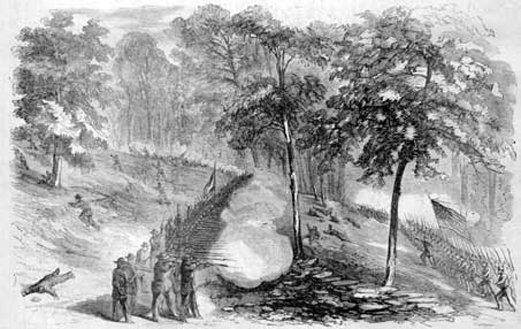
A great field success for him, came at South
Mountain on
September 14th, at the
Battle of Cramptons’ Gap. General Newton led his
brigade in a bloody bayonet charge that in co-ordination with others,
helped to rout an obstinate Confederate enemy from their
stronghold. It was a decisive victory for the
Union. General William B. Franklin, his Commanding officer
recommended Newton for promotion in his official report:
“While fully concurring in
the recommendation offered in behalf of
Colonels Bartlett and Torbert, who have certainly earned promotion on
this as on other occasions, I respectfully and earnestly request that
Brigadier-General Newton may be promoted to the rank of major-general
for his conspicuous gallantry and important services during the entire
engagement.”
Pictured
is, "Franklin's Corps Storming Crampton's Pass" by A.R. Waud,
Harper's Weekly, October 25, 1862.
A month later General Newton was given the command of a
Division in
the 6th Corps. But following the disastrous defeat of the
army at Fredericksburg, he stepped outside the bounds of good conduct
and military discipline.
At the time there was abundant loose talk in the high
command on the
lack of faith in the abilities of commanding general Ambrose Burnside
to lead the Army of the Potomac. Burnside was planning
another
river crossing when General Newton and one of his brigade commanders
decided to voice their concerns to authorities in Washington.
This was against military protocol, in which it would have
been
better for the senior commanding officers to worry about such
matters.
During an awkward interview with President Lincoln, General Newton
tried to explain the de-moralization of the army under Burnside’s
command. The gentleman with him, brigade commander,
John
Cochrane, was more direct and
critical of Burnside during the interview with Lincoln. The
difficult meeting added to President
Lincoln’s worries regarding divisive factions within the Army of the
Potomac at a time of crisis, when repeated military defeats caused
Northern morale to slip, and opponents of the war to become
more
vocal. Burnside was eventually removed, and General Newton
remained, but his part in the drama would later hurt his military
career.1
Nonetheless, he was promoted Major-General of Volunteers
in March
1863. To quote from John Hoptak’s short biography of General
Newton :
“…he led his division in attack against the Confederate
position along
the base of Marye’s Heights in Fredericksburg during the
Chancellorsville Campaign. He was slightly wounded during the storming
of the heights, and his men suffered tremendous loss with casualties in
his three brigades exceeding 1,000 killed, wounded, and missing, about
one-third the division’s total number.”2
This was his career so far, when General Meade calld
upon him to
replace John Reynolds in command of the First Corps.
NOTES:
1. A year later
when the army was
re-organized, General Newton was temporarilly left without a command.
A week later the recommendation for his promotion to
Major-General was withdrawn. He later obtained a command with
Sherman,
etc. It is possible he was removed for being 'squishy.'
2.
[John Hoptak's blog]
http://48thpennsylvania.blogspot.com/2009/04/major-general-john-newton.html
Return
to Table of Contents
Battle
Impressions of 3
Soldiers
There
is not a lot of source material in my collection from the
ninety-nine men of the regiment that made it to Cemetery Ridge on July
1st. But the three accounts I have are very good - if all too
brief. Here are Sam Webster, Company D, David Sloss, Company
B,
and William R. Warner, Company G & K.
Diary
of Sam Webster
Diary
of
Samuel Derrick Webster; (HM 48531) Excerpts
of this diary are used with permission
from The Huntington Library, San Marino, CA
Thursday, July 2nd, 1863
Second Corps came up last
night, and was
placed to our left, extending toward the Round Top. This
afternoon, as
the 5th Corps was arriving, the rebels opened toward Round Top,
and a
heavy fight took place there, they being beaten woefully. The
12th
Corps got here last night also, and were put to the right of the 11th
Corps, with their right flank drawn back towards the Baltimore
turnpike. The Sixth Corps (6th) came up late in the evening, and
was
held in reserve. Our fellows, likewise, were withdrawn to
reserve, in
rear of cemetery. Morris, Color Sergt, was killed yesterday,
and
Davie
Schloss, of the State flag was knocked down by the arm of one of 14th
Brooklyn, who was torn to pieces by a shell. His brains were
scattered
over the flag. Davie got up again, and took his colors,
however.
Quite a number of our officers were taken yesterday.
Letter
of David Sloss, Company B
Mr. James
Perry, David Sloss's descendant, found this letter and shared it with
me. Its source is the book Life
and
Letters of Alexander Hays, Pittsburgh, PA, privately
published 1919 p.
708; Fleming, George Thornton, ed; Hays, Gilver &
Adams, Company;
Pittsburgh PA. Mr. Perry still has a piece of the State Flag
his ancestor faithfully carried in battle.
Gettysburg Battlefield, July 5, 1863.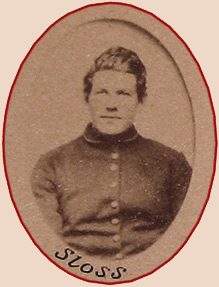
Dear Mother:
I wrote you a few lines about the first day’s
fight in
which our corps was engaged, but could not get it off until yesterday,
so I thought I might tell you some more about this battle, as it is
ended now, the ‘Rebs’ having left last night.
After getting out of the fight of the first day we
were
brought back of the town to support batteries in the cemetery until the
2nd day of July, when just about dark the Johnnies tried to turn the
left, and came very near being successful, but our division — eight
hundred men — were brought to bear on them and had a good effect by our
presence. As we went down the line everything looked like
Bull
Run, ‘Johnny Reb’ was trying his best to make it one by his fierce
shelling. The regiment ahead of us had seven men taken out by
a
solid shot.* Caissons and artillery stood out in bold relief
against the sky, without a horse or man near them. The
remnants
of regiments were taking off disabled guns, and everything looked blue
for our side, but the Rebels had been severely punished as well, and
they could not follow up their advantages. Our presence had
been
sufficient, so we went back to the graveyard and laid near the town
road. After night their pickets were very troublesome, but,
as we
were behind a stone wall, they did us no damage.
In the morning they commenced on the fifth, and
had
some very hot work with the Twelfth Corps. About noon they
commenced a terrible cannonading, and swept the hill upon which the
graveyard was, so that our safest place was right in front of our
batteries, and their batteries played on us and their sharpshooters
troubled us from the tops of the houses in the town. We lost
two
men by them. Added to this the sun came out terribly hot, and
a
lot of the division were affected by it. They commenced a
charge
about this time, and we were ordered under there fire to double-quick,
and away we went around the hill to help the Second Corps.
Colonel Coulter was hit, but not bad. He is in command of
our
brigade since Paul was shot. We just got in in time to see
the
‘Rebs’ break. It was a glorious sight to see, even if the
canister and shell were coming in thick, ‘old Hays,’ as his
boys
call him, ride up and down the lines in our front, with a Rebel flag
trailing on the ground. Such a wild hurrah I have never
heard,
nor saw such a sight, and never expect to see it again.
We immediately threw out skirmishers to cover the
field, but did not
advance. We laid flat on our faces so that they could not
trouble
us. They tried to advance on our left after this, but
succeeded
no better, as our line was so short across that we could easily
reinforce from left to right.
Dave.
*The shell fell amongst the men of the16th
Maine. More on
that later on this page.
Diary
of Lieutenant William R. Warner
Warner's
step descendant Mr. Eric Locher gaciously allowed me to present the
following Gettysburg excerpts from Warner's unpublished memoirs.
Warner's reminiscences skip around a bit from day 1 to day 2
and
so forth, so I have made a few edits to give them a little more order.
In view of the fact that
our Division on 2nd
& 3rd day, though constantly under fire
were owing to their
severe losses on 1st day and reduced numbers,
not placed in front
lines of battles, except as temporary supports, the writer has not
attempted
any detailed Account, even of matters which came directly under his
observation. — His
aim has been to
record a few impressions,
leaving descriptions to
those who had a more
active part. He
following his experience
about going under fire each day at Gettysburg. And I judge it
was
the
same with each of his
comrades. On 1st day, I think, when we heard of
Reynold’s death,
every man made up his mind, a battle was surely to be fought, but
events
followed so rapidly — the hasty throwing up of entrenchments at
Seminary, — the
brisk move to Oak hill, and we were under fire almost before we knew it.
Then
busy work put an end to
much thought about danger.
William
R. Warner's Scrapbook, came up for auction in the Autumn of 2015.
This image of 'Survivors of Company K, Taken at Westboro',
1911
was among those digitized. I have cropped the image.
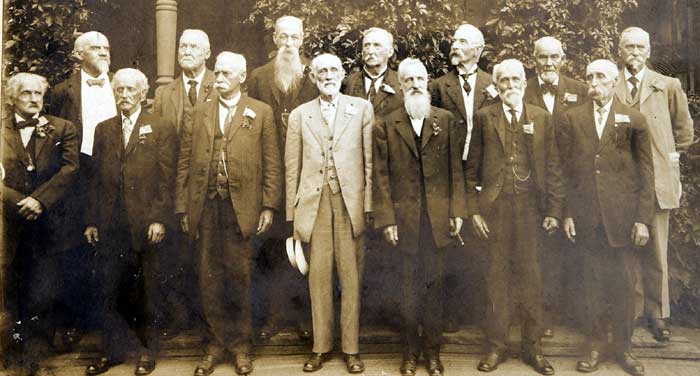
Pictured left to right, are
J. C. Thurston, W. R. Warner, Lyman Haskell,
Ira L. Donovan, Melville Walker, A. E. Chamberlain, John D. Plummer,
Frank Brigham, Frank Wilson, C. W. Comstock, A.C. Stearns, Lowell T.
Collins, Warren W. Day, & George W. Cliffords. Some
of these men
are listed in Warner's journal under his roster of Company K men
present at Gettysburg.
Members
of Co K, present at Battle
of Gettysburg
Captain
Charles H. Hovey – On
Staff duty – Wounded
1st
Lt. David Whiston
Taken Prisoner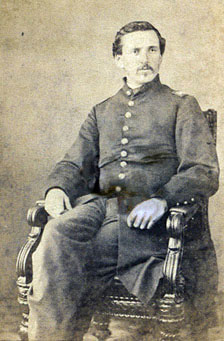
1 st
Lt. Samuel E. Cary,
“
“
1st
Lt. William B. Kimball, Former Member but
transfer to Co. A [pictured, right]
2nd
Lt. William R.
Warner “
“
“ Co.
E [pictured above]
Sergeant Willard Wheeler —
Killed
Sergeant A. C. Stearns Slightly
Wounded. [pictured above]
Corporal M. H. Walker Wounded
[pictured above]
H. A. Cutting — Wounded — Died
John Flye — Wounded — Died
M. O. Laughlan — Wounded — Died
Frank A. Gould —
Wounded — Died
George E. Sprague —
Wounded — Died
Charles M. Fay — Wounded
Slightly
L.
Vining — Wounded Slightly
Harvey
C. Ross — Wounded
Sergeant
William Rawson Taken
Prisoner
Corporal
James Slattery Taken
Prisoner
Corporal
A. L. Sanborn Taken
Prisoner
John
F. Bates Taken
Prisoner
George
W. Clifford Taken
Prisoner [pictured above]
Samuel
Jordan Taken
Prisoner
George
W. Hall Taken
Prisoner
Charles
F. Rice Taken
Prisoner
George
H. Seaver Taken
Prisoner
Henry
C. Vining Taken
Prisoner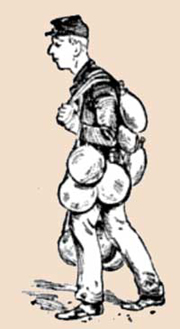
Edwin
C. Dockham
Frank
P. Wilson [pictured above]
Otis
Drayton
John
M. Hill
L.
Haskell [pictured above]
C.
W. Comstock [pictued above]
John
Glidden — Pioneer.
A.L.
Sawyer — Drummer
Michael
Lynch — Detached duty in Battery.
While halted near the Seminary, Lt. Whiston
detailed Charles
M. Fay & Otis Drayton to fill the canteens of the
Company. (K)
Fay’s recollection of it in 1885 is that there
were 27 of
them, which nearly accords with this list. It
is possible that several had all the water
they wished.
Fay states that they found a well at Seminary
& a crowd
getting water.
Leaving Drayton
to watch the pile, he filled them, a few at
a time. When they
had left [for] the
Regt. they found it gone, and followed on with their immence load of 27
canteens catching up, in the woods.
As showing in one
instance, how well the men stood up to
their work. I
recall that when order was
given, by which the Regiment came into line of battle &
immediately under
heavy fire, Company K being the extreme left Company had
quite a
distance to run, & in
coming into line, the files crowded each other rather
closely.
George Seaver of Co K, a
little fellow,
familiarly known as “Unkle
Nat” lost his
place & ran up & down, past his own & also Co
G, at least twice,
trying to get into his place. Finally some one grabbed him,
made an
interval
& he took his stand.
Return
to Top of Page
Colonel Coulter
Takes Command of Paul's
Brigade
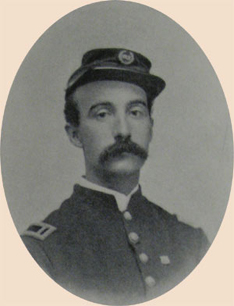
The morning of
July 2nd, Colonel Richard
Coulter of the 11th PA was ordered by General Robinson to take command
of General Paul's 1st Brigade. General Paul was permanently
out of action with a fearful wound to his head. Colonel
Leonard
of the 13th Mass., and Colonel Root of the 94th NY, the two
senior colonels of the 1st Brigade, were also away, wounded and
captured.
Coulter
transfered his regiment with him, and ordered Lt. Abner Small, the
adjutant of the 16th Maine, to his staff.
After the
war, Major Small, authored the 16th Maine regimental history,
and his own personal memoirs, 'The
Road to Richmond.' The latter was written for
his family but was published post-humously in 1939 by his son Harold
A. Small, one time editor of the University of California
Press.
The fortunes of the 16th Maine were intertwined with the 13th
Mass., and Major Small's expressive writing adds
detail left out by soldiers of the 13th. His depictions of
Colonel Coulter are priceless.
The following
narrative borrows from both of Major Small's writings,
beginning with
an excerpt from 'The
Road to Richmond.'
July 2d our corps had a new commander, General
Newton,
whom we didn’t know; an old regular, rather quiet in his bearing, and
with a large, kindly face and level eyes. Doubleday had
earned
the command, but was returned to his division.
Towards noon, we were
moved to the right and placed in support of batteries on Cemetery
Hill. All around our front and along the ridge beyond our
left
there was a continuous stir of preparation for more fighting. Colonel
Coulter acquainted himself with the condition of the brigade, and made
some staff appointments. I had a change of duty by the
following
order:
The following order was announced: —
General Order, No. 44.
Adjutant A.R. Small, 16th Me. Vols., is hereby detailed as
Acting Assistant Adjutant-General of this Brigade… He will be
obeyed and respected accordingly.
By command of Col. R. Coulter,
Com’dg Brigade.
Until mid-afternoon the day was not noisy; only
the
movements of troops near by, the occasional bark of a gun on the hill,
and father away the scattered rattle of skirmish fire, disturbed the
sultry quiet. Our men caught snatches of rest.
About
half-past three some rebel guns east of the town opened fire against
batteries not far from us, which replied, and the quarrel was kept up
through more than an hour. At the same time we began to hear
other cannonading away to our left, and towards evening we heard from
that direction the confused uproar of battle.
About sundown our brigade was hurried to the scene
of
action. Our way was swept by rebel artillery fire. As we
passed
the little house on the Taneytown road that was Meade’s head-quarters,
a shell burst in our regiment and severely wounded Lieutenant Beecher
and seven men.
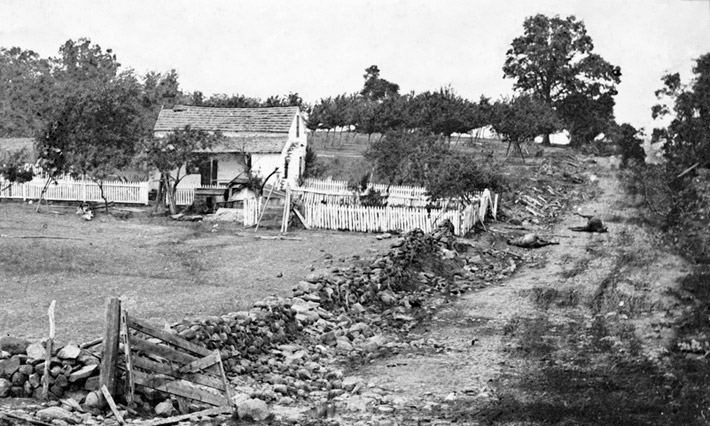
General
Meade's Head-quarters, the Leister House on the Taneytown Road, —
where the shell exploded as the 16th Maine passed by.
Note
the dead horses in the road. The soldiers of Coulter's
Brigade came down this road, toward the viewer.
David Sloss, William R. Warner & Charles
Davis, Jr. of the
'13th Mass.'
mention the incident of the shell landing in the ranks of the 16th
Maine.
The brigade dashed on at the double
quick.
We heard the shouted command, “By the right flank-march!” In
line
of battle we hurried on through smoke, over rough ground, into the
uproar, just as the rebels were driven back. The rush of grey
had
swept up through a battery. If I remember rightly, two of the
guns were brought off by our men. The enemy did not renew the
attack. We were marched back to our position on the right.
After dark, I should say about nine o’clock, we
were
moved down the front of the hill, under our batteries and near the
town. Rebel sharpshooters were firing from the windows of
houses near
by. A stone wall offered some protection to our brigade, and
the men
lay on their arms until morning.1
Colonel Coulter established his quarters in an “A”
tent,
pitched by his
orders on the brow of the hill at the left of cemetery, in the edge of
a grove, just in rear of the brigade’s last position on the second day,
and planted in clear view of the rebels the brigade flag.
From
this point I took in nearly the whole line from the cemetery to Weed’s
Hill. The position of the national line of skirmishers was
clearly defined by a streak of curling smoke that lazily faced into
thin vapor. The sky was clear, and a quiet aspect pervaded
everything --‘t was a moment of rest before a
battle. The
lazy attitude of men and horses, the apparent indifference of all the
army appointments, as the sun went down, afforded but slight indication
to a looker-on of the terrible storm gathering for the morrow – a day
ever memorable in American history. During the night eighty
thousand
men concentrated behind the rocky ridge in Lee’s front.2
NOTES
1. "The Road to Richmond", by Major Abner R.
Small, University of California Press, 1939; p. 103-104.
2.
"The 16th Maine Regiment in the War of the Rebellion
1861-1865", By Major A. R. Small, B. Thurston &
Company, Portland, Maine, 1886; p. 121.
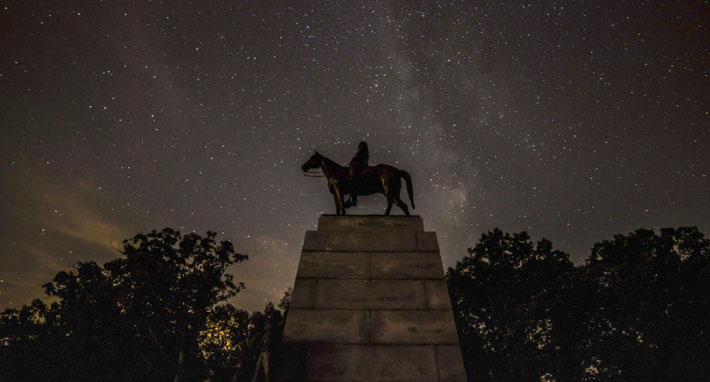
General Lee's Statue at
Night, Gettysburg. Photo by Buddy Secor.
Return
to Table of Contents
The '13th
Mass' on July 2nd
When writing
the Gettysburg narrative for the regiment in his history of the 13th
Mass., Charles Davis, Jr. borrowed heavily from the journal of William
R. Warner which was at his disposal. The two accounts
overlap, but both gentleman add personal anecdotes. Both
mention the shell which exploded among the remnant of the 16th Maine
during the hurried march to support the Union left in the early
evening. Davis made a poignant comment on the affair but
mistakingly inserted it into his entry for July 3rd. I have
included it here in its proper place.
I found both
accounts vague as to getting specific information as to what the
regiment did on July 2nd. The essay which follows these
entries titled, "So where exactly were they on July 2nd?" was the
result of my research to learn more.
Diary
of Lieutenant William R. Warner
Once
again I must thank Warner's step descendant Mr. Eric Locher for
allowing me to share this excerpt from Warner's unpublished manuscript.
Also - thanks to Buddy Secor for the incredible photographs.
His work can be seen at 'Ninja Pix"
on facebook & instagram.
Very early in the
morning, in the gray dawn, we were all
astir – Fresh troops were coming into position, and we felt assured
that the
entire Army of Potomac was close at hand.
A party of Officers came toward us, among whom
was Gen Hancock. Some
of our boys were exposing themselves on
top, & other side of the slight breastworks we had thrown up,
and Hancock
called out pleasantly, “Keep down, boys that is the way with you
Massachusetts
boys – too much damned curiosity – Keep down.”

The day passed, without
any active Movements on the part of
our Brigade & Division which was so reduced in numbers, it was
only
available as supports to other troops.
When Sickles was pushed back at nightfall, Robinson’s Division was
hurridly sent to the left, as re-inforcements.
Before we reached there, it had grown so dark, that the smoke &
fire
of the rebel artillery lighted up like sheets of flame —
Marching Brigade front, a
shell struck in
line of adjoining Regiment where the men had swayed closely together,
knocking
over I should think nearly a dozen men. How many were
killed, we knew not. We passed a Battery
on our right from which nearly every horse and at least half the men
were gone
– The tide had turned, and the rebel infantry had gone back.
Our lines were being re-formed and later in
evening, Our Division returned again to Cemetery Hill, where Hay’s
Louisiana
Brigade had attempted To take possession
of Ricketts & Wiedrick’s Batteries by an Evening Charge.
The Movement down to the
left in afternoon of 2nd
day, when we came under direct fire was a time, that tried men’s
courage— There
was no personal bravado, no cheers of excellent troops, it was looking
possible
death in the face & each man recognizing to himself, his own
helplessness
to avoid it and fate pushing him on quietly to take it all.
On Evening of 2nd
day, after Sickles repulse, as
we passed the Artillery which was being dragged from the field by men,
the
horses being killed, we passed several men drawing off by the legs,
what
appeared to be the headless body of an Officer. —
Colonel Coulter of 11th
Penn.
was in his best
fighting mood. It
was a weird scene —
darkness was fast settling down, and when a Cannon of the Enemy was
fired, it
showed a flame instead of smoke, until it seemed we could almost look
into
their Muzzles.

Col Coulter was shouting, “Let us Charge —
Let us give them Cold Steel by Moonlight.”
(photo by
Buddy Secor).
The following is from "Three Years
in the Army, The story of the Thirteenth
Massachusetts Volunteers from July 16, 1861 to August 1, 1864."
by Charles E. Davis Jr. Boston, Estes and Lauriat, 1894. p. 233-234.

Thursday, July 2.
By reason
of our hard
work of yesterday, we were to-day held
in reserve. It
often happens that this
kind of duty turns out to be more arduous than being stationed in line
of
battle, inasmuch as you may be called upon to march to any point that
needs
strengthening, as it happened with us on this particular day.
Upon
waking in the morning, we found everything astir with
excitement and preparation. Thousands
of
troops had gathered during the night, presenting a formidable
appearance in the
gray morning light. As
we were gazing about,
a party of officers were seen approaching, among whom was General
Hancock. Some of
the boys, regardless of danger, were
exposing themselves on top and at the sides of the earthworks that we
built
last night, when, in a mild, pleasant voice, General Hancock said,
“Keep down,
boys; that is the way with you Massachusetts boys – too much damd
curiosity;
keep down !’
In
the afternoon, as Sickles’ corps was being
pushed back at the peach orchard, our division was sent hurriedly to
his
support.
While
we were formed in line, marching brigade
front, a shell exploded in the midst of an adjoining regiment, knocking
over a
dozen men.

Historian Davis
commented on the incident of the shell exploding amidst the 16th Maine
troops in his narrative, but he mistakenly assigned the event to July
3rd; the wrong date. Here is what he wrote:
"During
the movement, an incident happened to show the hard luck that followed
a
gallant regiment. The Sixteenth Maine, during the first day’s
fight, was assigned the very difficult duty of holding on and delaying,
if possible, the advance of the enemy until the rest of the division
could get to the rear; and it did its work bravely and with great
credit to itself, its colonel and most of the men being take prisoners
in the endeavor. The remnant of about twenty men that escaped
were just ahead of us as we double-quicked along the ridge.
Suddenly a Whitworth shell from one of the enemy’s batteries exploded
in
their midst, and it seemed to us, as we hurried on over the mangled
bodies, that every man must have been killed. Our entire
division
at this time, consisting of eleven regiments, numbered only about nine
hundred men, and we felt sorry enough to see the remnant of this
excellent regiment so completely wiped out.
While these sights
were such as are commonly observed on all battlefields, they seemed
more hideous than any seen before, even to those familiar with such
scenes."
As the rebel infantry were
being driven back
at the moment of our arrival, our services became unnecessary, and
later in the
evening we returned to Cemetery Hill to support Ricketts’and
Wiedricks’s batteries,
which were being charged by the Louisiana Tigers. We were
thrown
in the
front
of these guns, with orders to hug the ground as closely as possible
while the
batteries fired over us. There
is no
more trying situation for a soldier than to be lying down in front of a
battery. He is only
a few yards in front
of the guns, and the concussion from each discharge seems to travel up
his
spinal column to the top of his head. The noise is terrible and
appalling. The
testimony of men who have undergone such
an experience is, that they endure more mental suffering than when
standing in
line of battle. You
are being constantly
pelted with the packings, as they become dislodged from the shells when
they
leave the muzzle of the gun. These
pieces are not dangerous though they often make an uncomfortable
contusion, the
size of a walnut, if they hit you. If a piece strikes you on
the
head
you will
think, as the boy did, that “you might as well be killed as scared to
death.”

A.R. Waud Sketch titled,
"Attack of the Louisiana Tigers on a Battery of the 11th Corps."
All the
afternoon we listened to the sound of battle at
our right on Culp’s Hill, dreading defeat and another
retreat. It
made us sick at heart
to think of what might
occur in such an event, and glad we were when night came and put a
temporary
stop to the fighting. Evidently
we had
not held our own at this point.*
So far as
exposure to danger is concerned, our division
may be said to have had very good luck.
There was hard fighting, at different points
all day, and even into the
night, without apparently any advantage having been gained by the Union
army. During our
absence to the left of
the line, where we were sent to help the Third Corps, there was hard
fighting
at Cemetery Hill, and by the time we got back the fighting was
practically over
at that point; so we escaped loss in both instances.
*NOTE: I find this
comment very confusing as far as the narrative goes. Although
there was an afternoon artillery duel between Union artillery on East
Cemetery Hill and part of a battery posted on Culp's Hill, with
Confederate artillery on Benner's Hill, the Confederate
infantry assault did not begin until the evening, and the '13th Mass'
were at another part of the field which is quite distant. I
believe Davis was trying to relate the emotions included in the source
material from William R. Warner and E. F. Rollins into his narrative.
The Warner Manuscript jumps around in its commentary so I can
see how Davis became unintentionally confused. See the
following essay for more information.
Return
to Top of Page
So,
Where exactly
Were They On Day 2?
View
looking west towards the enemy; from the position held by part of
Robinson's Division, the night of July 1st, through morning, July 2nd.
The Emittsburg Road is in the middle-ground.
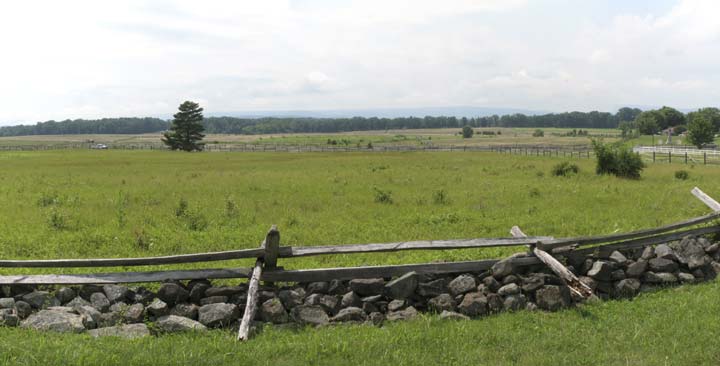
Having read the
entry as written above, in the regimental history, along
with William R. Warner's journal, I was still very
confused about what the regiment did on July 2nd. While
puzzling over this question I was fortunate to meet some very
knowledgable historians from Gettysburg, who offered to walk the field
with me to try and sort things out. A few weeks
later we did this.
I am
grateful to Bob George who printed out these cropped versions of the
John B. Bachelder maps of the battle for my reference.
And, to Steven Floyd,
an expert on the Gettysburg Monuments, and Craig Berkeley, who provided
information about the town at the time of the battle. We all
walked over the
ground together, and shared our knowlege of the battle. The
following essay is the result of all this study, and specifically shows
where and what the regiment did on July 2nd. An unintended
result of the research, is that it provides insight on General George
Gordon Meade's laudable command of the army during several extreme
emergencies on the 2nd day of battle. Click on any
map to view it larger.

So
far, we've heard from Adjutant Abner Small, of Colonel Coulter's staff,
and William R. Warner and Charles E. Davis, Jr., of the 13th Mass.,
regarding the
movements of Coulter's Brigade on July 2nd. But where was
Coulter's Brigade, and the 13th Mass. Regiment
actually positioned on the battle-field this day?
The soldiers used phrases like, 'we moved to the
right
near
the cemetery,' or,'we moved to the left as reinforcements.'
To
add to the confusion, Warner jumped around in his journal when he wrote
his entries for day 2, and Davis, who was not at the battle, followed
the same pattern in his narrative. The soldiers on
the field
made note of the impressions that were important to them, and these
small shifts in position were routine.
The
following essay is presented to sort things out, and show that these
troops
were much more active than they suggested. The hourly battle
maps
by Gettysburg historian John B. Bachelder are used as
reference. Bachelder made a life-long study of the battle,
and began gathering up information about troop positions by
interviewing participants as soon after the battle as he could.
He spent time in the camps of the Army during the winter of
1863-64. According to these hourly maps, Coulter's brigade,
(Paul's) held
five positions on July 2.
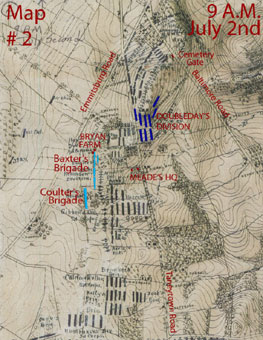
Starting with the position the regiment took up
after their retreat to Cemetery Hill, the evening of July 1st, we see
them in line just south of the Bryan Farm, extending south on
Cemetery Ridge to the angle in the Union line.
They were probably near the Bryan Farm where, as they wrote,
"Here we saw the division color-berarer standing alone.
Some of the boys then took the flag, and waving it in turn, shouting
and swinging their caps, soon succeeded in establishing the division
headquarters. While this was going on, others of the boys
went
actively to work bringing rails or digging, until we had a
well-formed
rifle-pit in readiness to again meet the enemy's attack; but we
remained un-disturbed during the night."
Early next morning, they woke up to General
Hancock riding the lines. Hancock's
2nd Corps moved into
their position, making it much stronger. Map #2
shows
Coulter's and Baxter's brigades still in position just south of the
Bryan Farm at 9 a.m., July 2nd. But now, they are surrounded
by troops
and
artillery of the 2nd Corps. Fortunately, things still
remained
quiet throughout the morning, giving the troops time to form their
lines un-molested. When the 2nd Corps was ready, Robinson's
Division moved
a
little to the east to join General Doubleday's Division, in reserve.
Here, these two First Corps Divisions remained at
rest behind troops
and batteries of the Eleventh Corps on Cemetery Hill.
(Wadsworth's
1st Division of the First Corps had taken a position on Culp's Hill,
farther to the east, and remained there throughout the battle.)
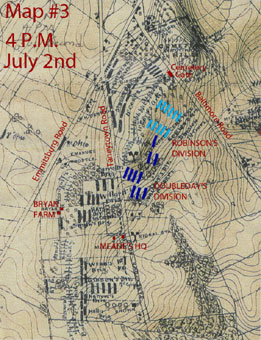
Map
#3 shows Doubleday and Robinson in reserve. The time is 4
p.m.
in
the afternoon, which marks the beginning of an artillery duel between
Union guns on East Cemetery Hill, and Confederate artillery
that moved up to Benner's Hill, not pictured on this map.
Neither William Warner or Charles Davis referred to the
afternoon
artillery
duel, and Adjutant Small of the 16th Maine merely mentions it. -- But
it
was close by their reserve position. Col. Charles Wainwright,
Chief of First Corps
Artillery, left a vivid description of the contest in his journal,
which follows.
(Wainwright's
guns can be seen north of
the Cemetery Gate, east of the Baltimore Road, on these maps.)
"About
four o’clock the enemy planted four twenty-pounder and six ten-pounder
Parrotts on a high knoll opposite our north front, and opened with a
well-directed fire. To this I was able to reply with thirteen
three-inch guns, so that the weight of metal was about equal, when you
add an occasional shot which Stevens was able to get in from his left
section. In every other respect the rebel guns had the
advantage
of us. They were on higher ground, and having plenty of room
were
able to place their guns some thirty yards apart, while ours were not
over twelve; and the two faces of our line meeting here, the limbers
stood absolutely crowded together. Still we were able to shut
them up, and actually drive them from the field in about two
hours. Their two right guns we could see them haul off by
hand;
they left twenty-eight dead horses on the ground, while we did not lose
over a dozen. How it was they did not kill more
horses I cannot
understand, huddled together as we were, for their fire was the most
accurate I have ever seen on the part of their artillery, and the
distance was just right, say 1,400 yards. Some of their guns
afterwards took position more to our left, at about 2,000 yards, but
were soon silenced. I being reinforced by a section of
twenty-pounder Parrotts which took position in the cemetery.

"I
saw during this artillery duel two instances of the destruction which
can be caused by a single twenty-pounder shot: both of which
happened within ten yards of me as I sat on the stone wall
between Cooper’s and Wiedrich’s batteries, along with General
Ames. One of these shot struck in the centre of a line of
infantry who were lying down behind the wall. Taking the line
lengthways, it literally plowed up two or three yards of men, killing
and wounding a dozen or more. Fortunately it didn’t burst,
for it
struck so near where we were sitting that it covered us with dust. The
other was a shell which burst directly under Cooper’s left gun, killed
one man outright, blew another all to pieces, so that he died in half
an hour, and wounded the other three.
Here I had a
specimen of the stuff this battery is composed of, and forgave Cooper
and his men their utter unmilitariness and loose ideas of discipline in
camp. So soon as the shell burst I jumped from the
wall, and
told Cooper to put on another detachment, that General Ames would let
some of his men carry off the wounded; not a murmur was uttered, but
five other men at once took place over their dead and wounded comrades,
and fired before they could be removed. I was very proud of
it. The man who was so badly blown to pieces lost his right
hand,
his left arm at the shoulder, and his ribs so broken open that you
could see right into him; he was removed to the well, just inside the
cemetery gates, and died there. Cooper came to me and asked
permission for his brother, who was their bugler, to go and remain with
him while he lived. The bugler, who had nothing to do, would
not
go sixty or seventy yards from his battery to see his brother in his
last moments without permission, nor would his captain give the
permission without asking mine. Yet were they in camp, hardly
a
man in the battery would go off for all day without permission to see a
well brother, and Cooper would think it all right.

"Our
artillery duel here was a mere divertissement, the rebels making their
charge on our left, where Sickles had thrown his corps in advance of
the rest of the line. I saw nothing of the affair, so shall
say
nothing, save that from what I can learn, the position chosen by
Sickles was a bad one. He lost a leg. Our men were
at
length driven back to where they should have been at first, and held
their own there, a good part of the Fifth and Twelfth Corps being sent
over there."1
The
artillery duel wasn't far off from the bivouac of the 13th Mass.
But if they were safe from exploding shells perhaps they just
slept through the noise. They were tired. (Did you
ever say
you to yourself, you were so tired you could sleep through a war?)
The artillery duel lasted perhaps an hour and 1//2.
Major
Small said, 'more than an hour,' and Wainwright said, 'about 2 hours.'
By
7 p.m. both Doubleday's and Robinson's troops were in motion to support
the hard pressed troops further to the left of the Union lines.
Sickles' salient had collapsed. Hard-pressed
Federal
troops
were trying to reform their lines on Cemetery Ridge, where they should
have been in the first place. General Meade was ever present
directing troops to fill in dangerous gaps in the line before the enemy
breached the position. General Newton was ordered to
hurry his reserve troops to the gap. The attacking
Confederates continued to gain ground. Meade's son, an
aide to the general at the time of the battle, tells the
story:
"For a few
minutes affairs seem critical in the
extreme. The Confederates appear determined to carry
everything before them. A vigourous
attack is made by them at various points along the whole
front.
Gibbon’s line becomes heavily engaged along
his whole front, while on his left, …there is the space still
unoccupied.
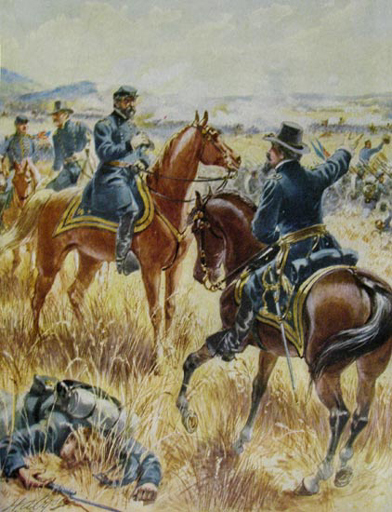
"At this gap,
waiting for the coming of
Newton, surrounded only by a few of his aides
and orderlies, stands Meade. The crash
of musketry and the shouts of the contending troops resound on all
sides, and
the air seems filled with shot and shell.
At this moment Meade sees at a short distance off a line of enemy
making
straight for the gap. Will nothing stop
these people? He glances anxiously in
the direction of the cemetery, whence succor should come. It
will be a disaster unless something can
stop these troops, if only for a brief space of time. The general
realizes the
situation but too well. He straightens
himself in his stirrups, as do also the aids who now ride closer to
him,
bracing themselves up to meet the crisis.
It is in the minds of those who follow him that he is going to throw
himself into the breach – anything to gain a few moments’
time.
Suddenly some one cries out, “There they
come, general!” and, looking to the right, Newton is seen galloping in
advance
of Doubleday’s division, at a sharp double quick, with muskets at a
right
shoulder, the two divisions sweep down the Taneytown Road, swing around
to the
right, and as, amid the wildest excitement and shouting, they press
forward to
the line of battle, Meade rides ahead with the skirmish line, waving
his hat,
saying to those about him, “Come on, gentlemen,” and some one remarking
that it
seemed at one time pretty desperate, it is pleasant to hear him reply
in his
hearty way : “Yes, but it is all right
now, it is all right now.”
"A
sharp fusillade follows. The
Confederates, exhausted by
their long, brave, and fruitless struggle for the mastery, are unable
to make
head against these fresh troops. The Federal lines advance, the enemy
is driven
back across the Emmettsburg Road,
all the guns that have been abandoned are recovered, and as darkness
comes over
the scene the musketry firing gradually dies away."2
Legend has it, (because polite society didn't talk
about
such things in those days) that General Newton, who
enjoyed his comforts, when he rode up to General Meade,
offered him his flask, and
asked if he would not like a drink. General Meade, who had
been
under tremendous strain, —up all night and the previoius day, took a
generous sampling of the flasks contents, — so the
story goes.

Bachelder's map 5, shows
Coulter's and Baxter's respective brigades in
position along the new Union line until 9 p.m.
Pictured on the map in front of Robinson's line
are indications of the troops of Brigadier-General Andrew A. Humphrey's
retreating
division, (near Baxter) and Colonel George R. Willard's Brigade, in
front of Coulter.
Humphreys division had held a line on the
Emittsburg Road in support of Sickles salient at the Peach Orchard.
But when the Peach Orchard fell to the enemy, Humphreys'
position became indefensible and he was ordered back to
Cemetery Ridge. He was being hotly pursued by the Confederate
brigades of Brigadier-General Cadmius Wilcox and Colonel David Lang,
who were making for the gap in
the Union line. (Lang's Floridians are listed on the map as
Perry's brigade)
Colonel Willard's brigade was moved down the ridge
to oppose the rapid Confederate advance from the Wheatfield.
Brigadier-General William Barksdale's attacking Confederates
were also approaching the
broad gap in the Union line. Both Colonel Willard and General
Barksdale fell in the bloody close combat that followed.
It was into this gap that General Meade anxiously
awaited the arrival of General Newton's men. Once the
battered troops of the 2nd and
3rd Corps re-established their position on Cemetery
Ridge, Robinson's division was once more called away to
another
part of the field in crisis. It may have been shortly before
9 p.m., or shortly after, reports vary.
The aforementioned artillery duel in the afternoon
at East Cemetery Hill was the pre-cursor to a Confederate attack on the
Union right.
During the crisis on the Union left, 12th Corps
commander, Major-General Henry Slocum pulled a whole division, and
another
brigade, from his defensive line on Culp's Hill, and sent them to
support the beleagured Federals on Cemetery Ridge. The
brigade arrived there in time to engage the enemy and help in the
repulse of Longstreet's attack, but the division (General
Ruger's) wasn't
needed, for Robinson's division had already come up about 15 minutes
earlier, and filled the gap. Slocum had sent too many troops,
and now the defenses of Culp's Hill were under-armed.
At
about
sunset, 3 Confederate Brigades attacked the hill.
Defending
it was the remnant of General James S. Wadsworth's 1st Division of the
First Corps, (badly cut up on July 1st) and a single brigade of
Slocum's 12th Corps, commanded by Brigadier-General George S. Greene.
Greene's right flank received the brunt of the
attack. Fortunatelly defensive breastworks built earlier in
the day provided cover for Greene's men while he sent to Generals
Wadsworth and Howard for help. Both commanders responded
quickly by sending several regiments to Greene's aid.
These troops relieved Greene's men as they ran low on
ammunition. The strong defensive works, the difficult hilly
terrain and the reinforcements were enough to repel the Confederate
attack by 9 p.m.

On East Cemetery Hill, where the artillery
duel took place in the afternoon, another simoultaneous attack was
under way. Colonel
Wainwright describes the situation:
"About an hour
after sundown, the moon shining brightly, the enemy made a push for our
position. Dr. Mosser, who was in the town, tells me that the
attack was made by the “Louisiana Tigers” and another brigade, the
lines being formed in the streets running north and south, and marching
out by the left flank. So soon as I caught sight of the head
of their column coming out, I sent Lieutenant Matthewson over to
Stevens’s battery to direct him to open on them, and had the other
batteries do so as the advancing columns came into view. They
marched straight out of the town, and then facing to their right rushed
for the hill. So soon as the rebels began to fire, the two
lines of Deutschmen in front of the batteries began to run, and nearly
the whole of them cleared out. As the enemy advanced we
commenced firing canister, depressing the guns more and more, until it
was one continual shower straight down the hill. The night was heavy,
and the smoke lay so thick that you could not see ten yards ahead;
seventeen guns vomiting it as fast as they can will make a good deal of
smoke. Feeling sure that no enemy could get up that front, I
now passed down the road beyond Stewart’s four pieces, so as to get a
view townward, for I could not get over my fear of an attack from that
quarter. All was quiet, and Stewart keeping a sharp lookout…
This attack made some inroads into the Union
Artillery position where
hand to hand combat ensued. Wainwright continues:
"I pitied
General Ames most heartily. His men would not stand at all,
save one. I believe not a single regiment of the Eleventh
Corps exposed to the attack stood fire, but ran away almost to a
man. Stewart stretched his men along the road, with fence
rails! To try to stop the runaways, but could do nothing.
Officers and men were both alike. Stewart’s men however got a
supper (they had been without food all day) for when they knocked a
Deutschman down, they took his haversack from him. But on the
other hand, the men of “I” Battery, also Germans, fought splendidly,
sticking to their guns, and finally driving the rebs out with their
hand-spikes and fence rails. Dr. Mosser tells me that a rebel
soldier whose wounds he dressed in town that night said that he was on
the hill, and that he saw one of the battery men snatch a musket out of
the hands of one of their men and drive the bayonet right through his
(the rebel’s) captain.

As the Confederate attack on the right
intensifiied, General Hancock back at Cemetery Ridge, heard the
fight growing in ferocity towards the cemetery, and ordered a brigade
over to help out since things had
quieted down on his imediate front.
General Carroll's brigade was sent. Wainwright's
journal entry continues:
"As the attack
was now evidently over, I ordered firing to cease so that the smoke
might clear off. While I was passing this order
along the line, and cautioning them at the same time to be prepared for
a second attempt, a lieutenant-colonel rode up and desired me to cease
fire as Carroll’s brigade of the Second Corps was going to charge down
the valley along my front on the rebel flank. I told him it
should be done, the order to cease firing having been already given,
but that I did not think he would find many live rebs there.
Which proved to be the case, though Carroll did strike the rear of the
retreating column, and brought off perhaps a hundred
prisoners…" 3
General Meade had also heard the battle raging on
the Union right and ordered General Newton to send Robinson's
division over to the sound of the conflict to help out. Once
again the 13th Mass, and others in their brigade changed position.
It was dark but they soon filed past Evergreen Cemetery to
the Baltimore Road, beyond which was East Cemetery Hill.
Because
the fighting had ended for the day, they remained at the cemetery in
reserve the rest of the night. It would appear from Map #6,
they were not thrown out in front of the guns of Wiedrick's &
Rickett's batteries until much later in the morning, July
3rd. The next map in the Bachelder series shows this, but
will be presented on the July 3rd page of this website.
What these maps, in conjunction with the soldiers
words do indicate, is that the 13th Mass regiment, with the other
troops in their division, played a very important role in the
battle of July 2nd, even though they were not engaged.
NOTES:
1.
A Diary of Battle. The Personal Journals of Colonel Charles
S. Wainwright, 1861-1865, edited by Allan Nevins, 1962. p. 243 - 244.
2. "With Meade at Gettysburg" by George Gordon
Meade, published by the War Library and Museum, Military Order of the
Loyal Legion, Philadelphia, PA, 1930; p. 127-128.
3.
Wainwright, p. 245 - 246.
Return
To Table of Contents
Sergeant
John Boudwin
& Private Bourne Spooner,
Prisoners in the Field
Diary
of Sergeant John Boudwin, Company A
The 1863 diary of Sergeant John
Boudwin
is noteworthy
for documenting his captivity at Belle Isle Prison in Richmond,
Virginia following the battle of Gettysburg. The cruel
suffering
from starvation and exposure, during his captivity in the
Summer
and Fall of
1863 is recorded for posterity. Those interested are
urged
to obtain a transcription from the Pearce Civil War Collections Museum,
Narvarro College, Corsicana, Texas.
Thursday, July 2. 1863
Came in
pleasant. Still a prisoner
inside the
Rebel
lines.
Skirmishing all along the line and at Noon a General Engagement took
place and it was a very heavy one - I could not tell which side got the
best of it but from some of the Rebels I heard that our forces had the
advantage.
My Rations all out and no chance to get any toward
dark
the Rebs killed
some Beef and I got a small piece after hard work. The Rebel
officers
wanted to parole us and our officers told us to Refuse it and we done
so as it was an illegal parole and would not be Recognized by our
Goverment. some have taken the parole and will be sent to
Carlisle
tomorrow and if not taken will be marched back to this place.
turned
in for the night and slept soundly.
The policy of
exchanging prisoners on the battlefield, and shortly afterwards, was
beginning to come into question at this time, over at the Lincoln
Administration. The two 'governments' would not agree on
policy for several reasons. Eventually it would cease
altogether and thousands would die in enemy prisons, especially in the
South. One wonders if Sgt. Boudwin and others realized the
refusal to accept the 'illegal' parole might cost them their lives,
that they might have more readily taken it.
Private Bourne Spooner's
Memoirs
Private Bourne Spooner,
Company D, was captured on the retreat from Oak Ridge on July 1st.
His unpublished memoirs written for his family several years
after the war relate some of his experiences. They were
shared with me by his descendants. This excerpt, continues
his narrative from the entries posted on the July 1st page of
this website. In contrast to Sgt. Boudwin, Spooner accepted
the 'illegal' parole.
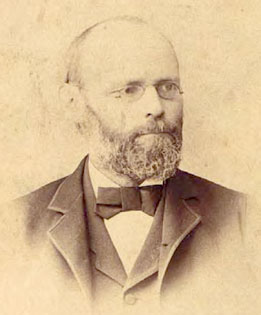
The following morning was remarkably quiet. We
remained
in that field I
should think until along towards the middle of the forenoon, and up to
that time I do not recollect of hearing a single hostile shot - not
even any dull, sleepy, straggling, intermittent picket
firing.
The atmosphere was mild and sunny, and the preparations of the great
battle went on without din or confusion. At the point where we were we
saw almost nothing of the enemy’s forces. Indeed, all the
while I
was a prisoner I did not see above three regiments of troops, and these
were just subsequent to my capture. While we remained in the
field we are kept in check by a small guard of slouchy sentinels and a
small mounted patrol beyond.
Some time near the middle of the day we moved from
our
rather crowded
quarters to a more eligible spot. We moved out and passed out
somehow to the left through a huge piece of woods to a spot I should
think somewhere in the right-rear of the enemy’s position. We
were
guarded in our march by a body of cavalrymen. I recollect of
feeling sort of chagrin at our situation as we moved along, there being
as I recollect little if any conversation between captors and
prisoners. Our new quarters were a hollow in a wheat field
through which flowed a brook. Towards afternoon the cannonade
proclaimed that the battle had been renewed, and it was a novel and not
altogether unpleasant sensation for us to know that a battle was going
on around us and that we shouldn't be called upon for duty.
We remained at this place through this and the
following
day, and of
some of the incidents I recall I cannot distinctly remember which day
they occurred on. We roamed about at will within our
circumscribed
limits, though in a measure each regiment kept by itself. The
Thirteenth were mostly on a gravelly side hill. The wheat was
soon completely trampled down; but, as the rebs were not at
all
lavish
of their provender, some of the men who had been captured with empty
haversacks made some attempt to extract the kernels from the wheat with
which to appease their hunger.
I recollect seeing some
finely
mounted and stylishly caparisoned officers ride by where we were, one
of which was pointed out as an English officer, who was a guest at
Confederate headquarters.* Ammunition and commissary trains
went
to and from the front along a road near, and occasionally there passed
a section or so of artillery. Some of us engaged in
conversation
with the guards who appeared but little amenable to
discipline.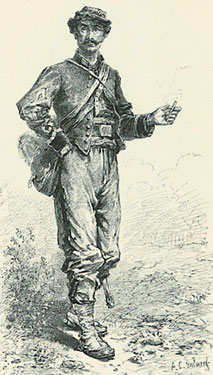 They sat or stood as best pleased them or entered into a full
discussion of the questions of them. They defended slavery,
the
southern cause, etc., while we opposed them. They also talked
of
the events of the war. One, I remember, maintained that
General
Ewell worthily filled the place of “Stonewall” Jackson and also gave it
as his opinion that the latter was not killed by his own men but by our
troops. Two of the guards I also recollect got into an
altercation, and one threatened to shoot the other, but afterwards
calmed down. Indeed the temper of these men seemed to be more
violent and a disposition more to resort to extreme acts in settling
disputes than is customary with our more temperate people.
However, their treatment of us during our brief captivity was all that
could be desired. Nor were they at all rampant on the subject
of
their own prowess; they maintained a quiet but complete confidence that
they were to triumph in the battle.
They sat or stood as best pleased them or entered into a full
discussion of the questions of them. They defended slavery,
the
southern cause, etc., while we opposed them. They also talked
of
the events of the war. One, I remember, maintained that
General
Ewell worthily filled the place of “Stonewall” Jackson and also gave it
as his opinion that the latter was not killed by his own men but by our
troops. Two of the guards I also recollect got into an
altercation, and one threatened to shoot the other, but afterwards
calmed down. Indeed the temper of these men seemed to be more
violent and a disposition more to resort to extreme acts in settling
disputes than is customary with our more temperate people.
However, their treatment of us during our brief captivity was all that
could be desired. Nor were they at all rampant on the subject
of
their own prowess; they maintained a quiet but complete confidence that
they were to triumph in the battle.
Among us prisoners were a few Pennsylvania
militia,
distinguished from
the others by their new uniforms and rather ill-at-ease
manners.
A very large force of these “home guards” were called out on Lee’s
invasion to hold him in check, but of course did little or nothing to
interpose his progress. A reb officer laughingly related to
some
of us prisoners that a small scouting party of horse to which he was
attached, together with one piece of artillery, suddenly came across a
brigade of these militia drawn up in battle array near a bridge on the
south bank of the Susquehanna. One or two shells, he said,
was
all that was necessary to send the whole crowd “skedaddling” across the
stream.
*The Foreign Visitor was Sir
Arthur James Lyon
Freemantle, who spent 3 months traveling in the South on his own bill.
He made a point to meet General James Longstreet who agreed
to let him accompany the
Confederate Army for a while.
Freemantle
wrote of his experiences in a book titled Three Months in the Southern
States, published in 1864.
Return
to Top of Page
Sergeant
Austin Stearns -
Prisoner in the Town

Sergeant
Stearns was slightly wounded on July first, and claimed the privilege
of being a wounded soldier at the First Corps Hospital in town rather
than a prisoner, confined with others elsewhere to be marched south to
Rebel prisons. The hospital was at what is today Christ
Lutheran Church on Chambersburg Street, but was then known as
the College Church. This excerpt is from his memoirs, Three
Years
with Company K, edited by Arthur A. Kent, p. 186-192. Used
with
permission.
On the
morning of the 2d I was astir early, and did what I could to make
Harvey comfortable, then went down and saw the other boys, and with
Charlie Fay started out on the street to see and hear what we could and
if possible get something to eat. It was still quite early,
but
there were soldiers moving all around. We went to several
houses
and rang their bell but could raise no one. At last we saw a
lady
cross the street and enter a house, [so] we knew there was someone
there and went directly and rang the bell. An elderly lady came to the
door, and we asked her if we could get anything eatable
there.
She said [we] could not. Seeing a pump near, I asked her if
she
could loan us a towel. I don’t know what she thought of that
request, for without saying a word she went and brought one for us, but
her actions showed that she thought us cheeky. Perhaps she
thought us rebs, and if so her actions are very excusable. We
went
to the pump and gave ourselves a good wash and wiped ourselves on that
clean towel, then, going to the door again, we rang the bell and with
many thanks returned it to the lady.
There were rebel soldiers everywhere, in the
streets,
backyards – all
around you could see them.
Going
up a street that led by the court house, we came to a line of rebels
with their guns stacked. Not thinking but what they told us
last
night was true about our army, we kept right on through their line,
going about a rod, when one of them with a gun in his hand
said:
“Hello
Yanks; where you at?” We told him “We’re going this way just
a
little.” 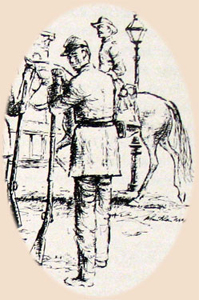 He
said with a smile, “If you
Yanks don’t wish to
get
shot, you hadn’t better travel that way any
farther.” We told
him
we wished to keep within our limits, and were sorry that we had passed
them. As he seemed inclined to talk, we felt to take the
liberty
to ask a few questions, and the first one was: “Where is the
union
army?” He laughed again and pointed to the hill, said “Look
there.” We looked in the direction he pointed, and there,
sure
enough, was the old stars and stripes waving in the morning sunlight,
with a battery its muzzles pointing directly at us. We said,
some
of your fellows told us last night that the union army were ten miles
away, [and] he said “he wished they were, but he thought the fellows
had not been where he was.” Thinking that the locality might
under certain conditions be extremely unhealthy, and not caring to stay
so near, or as we were outside their lines, we concluded not to stay
there longer and started to go back. We crossed the street
and
just then a reb came up with a barrel about half full of little
crackers; the crackers were an inch square. He turned them down on the
sidewalk and cried out as loud as he could yell, “Fall in for
rations.” The rebs jumped up from all around and came running
for
their share; other rebs were coming bringing barrels. As they
did
not extend the invitation to us, we thought it best not to help
ourselves, so we passed on. He
said with a smile, “If you
Yanks don’t wish to
get
shot, you hadn’t better travel that way any
farther.” We told
him
we wished to keep within our limits, and were sorry that we had passed
them. As he seemed inclined to talk, we felt to take the
liberty
to ask a few questions, and the first one was: “Where is the
union
army?” He laughed again and pointed to the hill, said “Look
there.” We looked in the direction he pointed, and there,
sure
enough, was the old stars and stripes waving in the morning sunlight,
with a battery its muzzles pointing directly at us. We said,
some
of your fellows told us last night that the union army were ten miles
away, [and] he said “he wished they were, but he thought the fellows
had not been where he was.” Thinking that the locality might
under certain conditions be extremely unhealthy, and not caring to stay
so near, or as we were outside their lines, we concluded not to stay
there longer and started to go back. We crossed the street
and
just then a reb came up with a barrel about half full of little
crackers; the crackers were an inch square. He turned them down on the
sidewalk and cried out as loud as he could yell, “Fall in for
rations.” The rebs jumped up from all around and came running
for
their share; other rebs were coming bringing barrels. As they
did
not extend the invitation to us, we thought it best not to help
ourselves, so we passed on.
When we got back to the church we
made an examination of our haversacks to see what they
contained.
In mine I found a piece of pork and about a double handful of hardtack
crumbs. Fay could find nothing in his. We fried the
pork,
and then the crumbs in the fat, and made a pot of coffee using the last
we had. We ate this with a relish.
I then went into the
church to see the boys. I found there in addition to Ross,
Serg’t
M.H. Walker wounded in foot, Privates G. E. Sprague in chest, M.
O’Laughlin, in knee, Frank Gould in hip and back, Horatio Cutting in
head, Albion Vining in foot. Cutting, Gould, O’Laughlin, and
Sprague all died in a few days. All the boys were in as good
spirits as
could be expected, and were all pleased to know that the old flag was
still in sight. With the exception of Ross they were all in the same
room, the vestibule of the church. In the vestry proper was
the
amputation room. I went in there for a few moments to see how
they were doing the business, but it was so full, and the weather so
warm, and such an unpleasant odor of ether that I was glad to come
out. While there I saw a stout young soldier, whose arm had
been
taken off near the shoulder, just as he began to realize what had been
done to him – the puzzled look, and then the tear that filled his eye
when he realized that his good right arm was gone.
While out
behind the church in the yard cooking our breakfast, there were rebs
and union men, and there two brothers met, one dressed in blue, the
other grey, and with the exception of their uniforms both looked just
alike. Both were little, red-faced, red-haired, stubby
Irishmen,
and both blubbered, and cried, and hugged each other as only Irishmen
can who have a “drop of the sweet cratur in.” The union man
wanted the reb to go with him and leave the cause of the south, while
the reb didn’t see how he could go when the union man was a prisoner
and would perhaps have to go south whether he wanted to or
not.
How they decided it I never knew, for I left the yard and never saw
them again.
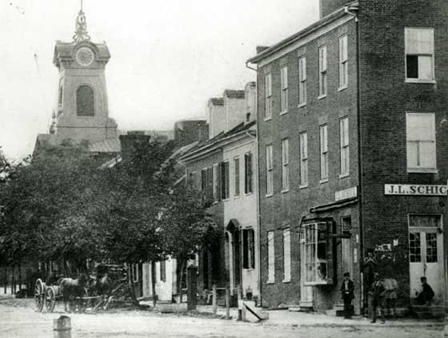
I went up the street to the “Diamond,” as they
called it – we at home would call it the “Square” – to see and hear
what was going on. As I was going along I saw a door open,
and
thought I would just look in and see how trade was, as it was a country
grocery store. As I stepped in I saw it was in possession of
a
half dozen rebel soldiers, and they were having things all their own
way. Some stood on the counter, others were behind, and all
were
busy; such things as they wanted they laid aside in a pile and the
others they gave a toss on to the floor. One of them looking up
said,
“What does that dammed Yank want?” Thinking my presence might
not
be agreeable to them, I turned to go out, while they gave one of their
peculiar yells.
Pictured is
Baltimore Street, view south from the Diamond. The Court
House on the left of the image.
On going back towards the church I saw a
rebel
ambulance standing before the door with several of our Surgeons
standing besides it earnestly talking. On getting near I heard
they were talking about some one in the ambulance. On looking
in
I saw there, dressed in a rebel uniform and very weak from the loss of
blood, John Flye, the first man or our company hit. I told
the
surgeons that I knew that man, that we were of the same company, and
they immediately ordered him to be taken in. Flye was left on
the
field, and the rebs finding him, and seeing his cloths covered and
growing stiff with blood, had exchanged his pants for one of
their own and brought him in. The surgeons, seeing him in
grey,
could not believe he was a union soldier. Flye died in a few
days.

(Pictured, left
to right, Dan Warren and John Flye, Company K, Williamsport, MD.,
Winter, 1862)
The
rag-tag and bob-tail of the rebs came straglin along down the street,
and they composed almost every nationality and were of themselves quite
an army. I was surprised to see so many in the southern army,
for
I had thought they had none; this army that I saw I suppose comprised
some of the officers servants, for their talk and appearance indicated
it. Their outfit comprised almost everything you could think
of,
from
the great Penn farm horse that they [had] stolen from some farmer, and
then loaded with whatever pleased their fancy, and almost invariably
mounting on top of the whole there were bed blankets, and all
kinds articles, useful as well as ornamental. Tin dishes and
straw hats they seemed to have a great liking for. I saw one
fellow that had his horse almost loaded down with tin dishes, and
another with straw hats, and several that had from one to a
dozen. One darkey had three black silk hats on his head and
as
many more under his arm. One fellow that had an eye to ease and comfort
had a horse and wagon and seemed to be taking comfort. I
talked
with a few of them, but they were very insolent, and were full of the
braggadocio, so I refrained from talking and simply looked on.
In
the afternoon while [I was] in the church with the boys, the surgeons
came around to make an examination of Mike O’Laughlin’s wound; he was
shot through the knee, and the bone was badly smashed. They
gave
it a pretty thorough looking over, and concluded it must be taken
off. Mike cried like a baby when the surgeons made their
decision, and plead his poverty and an aged Mother that was dependent
on him as a reason why he could not part [with] it. I pittied
him, as did all the surgeons, and they promised to wait a few days
before taking it off, but poor Mike, he lost his limb and his life as
well. We had found out now that the union army was but just
outside the town, that from some points we could see the old flag, and
indeed our experience of the morning had shown it to our view.
Bullets
came whistling over and around, to tell that there was life in the old
army still and that they were but a short distance away; but what an
insurmountable barrier lay between.
The firing through the day had
not been very heavy, only occasionally a shot being fired to feel the
enemy, till just at night it broke out like a tornado in the vicinity
of Cemetary Hill. Being wholly unprepared for such a storm,
we
were taken by surprise and awaited with anxious hearts the
results. We knew not how many, or what condition the old army
was
in.
We could not know whether the new levies of troops
had
arrived and were taking part, whether it was our men who were attacking
or the rebs. All we knew was, that there was a terriable
struggle
going on near. Our suspense was of short duration for soon
the
rebels came swarming back down, even as far back as we were, and as I
was out on the street at the time, I saw them as they came along and a
madder set of men I never saw. They cursed their officers in
a
way and
manner that showed experience in the business, and one that would
completely eclipse the best endeavors of a union soldier. It
was
simply fearful.
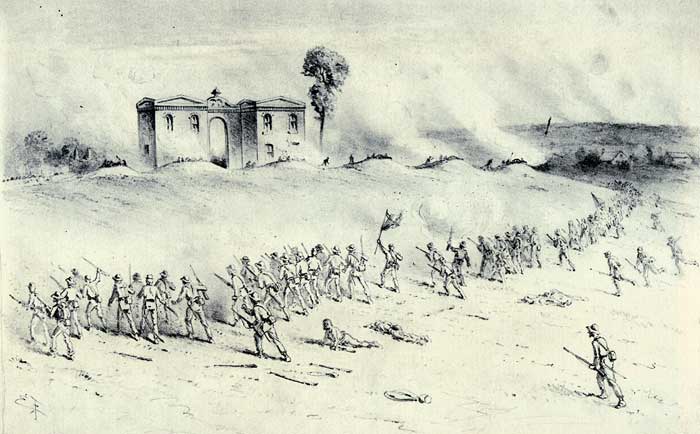
Artist Edwin Forbes did
this illustration titled,
"Confederate Attack on Cemetery Hill." Although it is not as
dramatic as Waud's sketch, 'Attack of the Louisiana Tigers on a Battery
of the 11th Corps,' shown above, this picture gives another
view
of the Confederate assault Austin Stearns heard about in
town. Forbes
artist's studies were made after the battle and from eyewitness
accounts
and his own examination of the battlefield two days after fighting
ended.
I enquired the nature and cause of all this
outburst of feeling of some of the quieter ones, and this is the story
they told me. They belonged to Hays’ brigade of Texas troops
and
were laying close up under Cemetary Hill when they were ordered to the
charge.* They said they went up the hill before the gunners
had
time to depress their pieces to fire at them, and drove the gunners
away and were trying to turn the pieces, when the infantry supports of
the batteries came up and they had a short hand to hand
conflict.
But our boys were too
many for them, and they, not receiving any support, were driven back
with considerable loss. They said it was always so;
if
there was
to be any hard fighting, they were always the first to be brought in,
and then there was no help given them. They said their
officers
didn’t care how many were killed, and especially old Hays, who was
receiving his share of the curses. The truth of the story I
cannot vouch for; I only tell it as it was told me by a crowd
of
rather
excited Texan soldiers at the close of a hot July day. At any
rate, it was a sharp fight with no advantage to the rebs.
*Brigadier-General Harry T.
Hays, CSA in command of a Brigade in Lieutenant-General. Richards
S. Ewell’s (Second) Corps, Army of Northern Virginia.
Return
to Top of Page
General
Meade's 'Council of
War'
An hour after
General Meade wrote to General-in-Chief, Henry
Halleck in Washington, he called a meeting of his corps commanders.
Meade had reported to Halleck, that he intended to
stay in his present
position. Whether his operations would be of an offensive or
defensive character would depend upon information he recieved about his
army. The commanders gathered in the small front room of the
Leister house to discuss matters. General John Gibbon of the
2nd Corps wrote an account of it.
From Battles
& Leaders of the Civil War, Volume 3, p. 313,
Century Company, New York, 1884, 1888
The
Council of War on the Second Day
By John Gibbon,
Major-General, U.S.V.
Soon
after all firing had ceased a staff-officer from army headquarters met
General Hancock and myself and summoned us both to General Meade’s
headquarters, where a council was to be held.  We
at once
proceeded there, and soon after our arrival all the corps commanders
were assembled in the little front room of the Liester House – Newton,
who had been assigned to the command of the First Corps over Doubleday,
his senior; Hancock, Second; Birney, Third; Sykes, Fifth; Sedgwick, who
had arrived during the day with the Sixth, after a long march from
Manchester; Howard, Eleventh; and Slocum, Twelfth, besides General
Meade, General Butterfield, chief of staff; Warren, chief of engineers;
A.S. Williams, Twelfth Corps, and myself, Second. It will be
seen
that two corps were doubly represented, the Second by Hancock and
myself, and the Twelfth by Slocum and Williams. These twelve were all
assembled in a little room not more than ten or twelve feet square,
with a bed in one corner, a small table on one side, and a chair or
two. Of course all could not sit down; some did, some lounged
on
the bed, and some stood up, while Warren, tired out and suffering from
a wound in the neck, where piece of shell had
struck him,
lay down in the corner of the room and went sound asleep, and I don’t
think heard any of the proceedings. We
at once
proceeded there, and soon after our arrival all the corps commanders
were assembled in the little front room of the Liester House – Newton,
who had been assigned to the command of the First Corps over Doubleday,
his senior; Hancock, Second; Birney, Third; Sykes, Fifth; Sedgwick, who
had arrived during the day with the Sixth, after a long march from
Manchester; Howard, Eleventh; and Slocum, Twelfth, besides General
Meade, General Butterfield, chief of staff; Warren, chief of engineers;
A.S. Williams, Twelfth Corps, and myself, Second. It will be
seen
that two corps were doubly represented, the Second by Hancock and
myself, and the Twelfth by Slocum and Williams. These twelve were all
assembled in a little room not more than ten or twelve feet square,
with a bed in one corner, a small table on one side, and a chair or
two. Of course all could not sit down; some did, some lounged
on
the bed, and some stood up, while Warren, tired out and suffering from
a wound in the neck, where piece of shell had
struck him,
lay down in the corner of the room and went sound asleep, and I don’t
think heard any of the proceedings.
[Pictured,
Generals, Barlow, Birney, Gibbon, & Hancock, who is seated].
The discussion was at first
very informal and in the shape of conversation, during which each one
made comments on the fight and told what he knew of the condition of
affairs. In the course of this discussion Newton expressed the opinion
that “this was no place to fight a battle in.” General Newton
was
an officer of engineers (since chief-engineer of the army), and was
rated by me, and I suppose most others, very highly as a soldier. The
assertion, therefore, coming from such a source, rather startled me,
and I eagerly asked what his objections to the position were.
The
objections he stated, as I recollect them, related to some minor
details of the line, of which I knew nothing except so far as my own
front was concerned, and with those I was satisfied; but the
prevailing impression seemed to be that the place for the battle had
been in a measure selected for us. Here we are; now what is
the
best thing to do? It soon became evident that everybody was
in
favor of remaining where we were and giving battle
there.
General Meade himself said very little, except now and then to make
some comment, but I cannot recall that he expressed any decided opinion
upon any point, preferring apparently to listen to the
conversation. After the discussion had lasted some time,
Butterfield suggested that it would, perhaps, be well to formulate the
question to be asked, and General Meade assenting he took a piece of
paper, on which he had been making some memoranda, and wrote down a
question; when he had done he read it off and formally proposed it to
the council.
I had never been a member of a council of war
before (nor have I been since) and did not feel very confident I was
properly a member of this one; but I had engaged in the discussion, and
found myself (Warren being asleep) the junior member in it.
By
the custom of war the junior member votes first, as on courts-martial;
and when Butterfield read off his question, the substance of which was,
“Should the army remain in its present position or take up some other?”
he addressed himself first to me for an answer. To say “Stay
and
fight” was to ignore the objections made by General Newton, and I
therefore answered somewhat in this way: “Remain here, and make such
correction in our position as may be deemed necessary, but take no step
which even looks like retreat.” The question was put to each
member and his answer taken down, and when it came to Newton, who was
the first in rank, he voted in pretty much the same way as I did, and
we had some playful sparring as to whether he agreed with me or I with
him; the rest voted to remain.
The next question written by
Butterfield was, “Should the army attack or wait the attack of the
enemy?” I voted not to attack, and all the others voted
substantially the same way; and on the third question “How long shall
we wait?’ I voted, “until Lee moved.” The answers
to this
last question showed the only material variation in the opinion of the
members.
When the voting was over General Meade said
quietly,
but decidedly, “Such then is the decision”; and certainly he said
nothing which produced a doubt in my mind as to his being perfectly in
accord with the members of the council.
In
1879
artist James Edward Kelly began a study and interviewed
several of the generals present at General Meade's gathering
of field commanders. The result of his research is the
following sketch.
I have not been able to find proper attribution
for all the
generals depicted but offer my best educated guess.
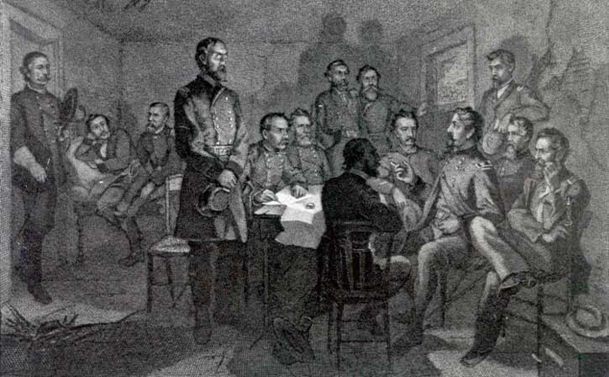
Pictured left to right,
Cavalry Corps Commander
Major-General
Alfred Pleasonton, who was not
there, Chief Engineer G. K. Warren, 1st Corps Commander
Major-General John Newton, General Meade, Chief of Staff
Major-General Daniel Butterfield, 6th Corps Commander Major-General
John
Sedgwick, standing in back - 11th Corps Commander
Major-General Oliver O. Howard, &
12th Corps Commander Brigadier-General Alpheus S.
Williams, seated in front Chief Quarter-master Rufus Ingalls
who was not
there, then, Wing Commander Major-General Slocum, Wing Commander
Major-General Hancock, 2nd Corps Commander
Brigadier-General John Gibbon, (standing), 3rd Corps
Commander, Major-General David B. Birney, and 5th Corps
Commander Major-General George Sykes.
In 1881 (eighteen
years after the battle) I was shown in Philadelphia, by General Meade’s
son [Colonel George Meade], a paper found amongst General Meade’s
effects after his death. It was folded, and on the outside of
one
end was written, in his well-known handwriting, in ink, “Minutes of
Council, July 2d, 1863.” On opening it, the following was
found
written in pencil in a handwriting [General Daniel Butterfield’s]
unknown to me:
At the
council of corps commanders held on
this day the following questions were asked:
Minutes of
Council July 2d, 1863.
Page 1, Questions asked:
1. Under existing
circumstances, is it advisable for this army
to remain in the present position or to retire to another nearer its
base of
supplies ?
2. It being determined to
remain in present position, shall the
army attack or wait the attack of the enemy ?
3. If an attack, how long ?
REPLIES
Gibbon:
1. Correct position of
the
army, but would not retreat.
2. In no
condition to
attack, in his opinion.
3. Until he moves.
Williams:
1. Stay.
2. Wait
Attack.
3. One
day.
Birney:
Same as General Williams.
Sykes:
Same as General Williams.
Newton:
1. Correct position of the
army, but would not retreat.
2.
By all means not
attack.
3.
If we wait, it
will give them a chance to cut our line.
Howard:
1. Remain.
2.
Wait attack until
4 P.M. to-morrow.
3. If
don’t attack,
attack them.
Hancock:
1. Rectify position without
moving so as to give up field.
2.
Not attack unless
our communications are cut.
3.
Can’t wait long;
can’t be idle.
Sedgwick:
1. Remain.
2. and wait
attack
3. At
least one day.
Slocum:
1. Stay and
fight it
out.
[On the back, or first page of the sheet]:
Slocum
stay and fight it out. Newton thinks it a bad position;
Hancock puzzled about practicability of retiring;
thinks by
holding on inviting to mass forces and attack. Howard favor of not
retiring. Birney don't know. Third Corps used up and not in
good
condition to fight. Sedgwick doubtful whether we ought to
attack.
Effective strength about 9000, 12,500, 9000, 6000, 8500,
6000,
7000. Total, 58,000.
[Endorsement:]
Minutes
of Council, held Thursday, P.M., July 2d, 1863. D.B., M.G.,
C.
of S. [Daniel Butterfield, Major-General, Chief of
Staff].
The
memoranda at the bottom of the paper were doubtless made while the
discussion was going on, and the numbers at the foot refer probably to
the effective strength of each corps.*
Several times during the
sitting of the council reports were brought to General Meade, and now
and then we could hear heavy firing going on over on the right of our
line. I took occasion before leaving to say to General Meade
that
his staff-officer had regularly summoned me as a corps commander to the
council, although I had some doubts about being present. He
answered, pleasantly, "That is all right. I wanted you here."
Before
I left the house Meade made a remark to me which surprised me a good
deal, especially when I look back upon the occurrence of the
next
day. By a reference to the votes in council it will be seen
that
the majority of the members were in favor of acting on the defensive
and awaiting the action of Lee. In referring to the matter,
just
as the council broke up, Meade said to me, "If Lee attacks
to-morrow, it will be in your
front."
I asked him why he thought so, and he replied, "Because he
has
made attacks on both our flanks and failed, and if he concludes to try
it again it will be on our center." I expressed the hope that
he
would, and told General Meade, with confidence, that if he did we would
defeat him.
*A careful study of the
orignal suggest
that these notes "at the bottom" (on the back) were made before the
questions were formulated. - Editors [B&L]
Return
to Table of Contents
Lost
Among The Dead
I found the
following
article in "Bivouac, A
Military Monthly
Magazine;"
Volume 1, pages 39-42. It comes from the book "Bullet
&
Shell, War as the Soldier Saw It" by G. F. Williams. The book
is
a fictional account of a soldier's experiences. I'd like to
believe Williams wrote this from a personal account.
He
was a soldier and a war correspondent during the conflict.
The horror of
this story is
tangible. It echoes late author Gregory A. Coco's work "A Strange and Blighted
Land,
Gettysburg: The Aftermath of a Battle." A
lot is
said,
appropriately so, about 'glory,' 'bravery,' and 'honor,' won on a
battlefield, but it's still a battlefield, replete with tragedy and
horrors once
the smoke clears.
LOST
AMONG
THE DEAD AT GETTYSBURG
From Bullet and Shell. By G. F. Williams.
“I had proceeded but a short distance,
when I became aware I
was on new ground ; the rocks and bowlders over which I had stumbled
being no
longer in my path. This was a dilemma
for which I had little relish, for I was anxious to reach my command as
soon as
possible. I knew it was dangerous to
shout, for I might draw upon me the fire of my own pickets; and there
would be
little glory in being shot by Federal bullets.
Impatient and angry at my own stupidity
in not having kept
the bearings of my position, I took careful survey of the lights along
our main
line, hoping by that means to discover the rocks. But
the fires on the interior lines were
smouldering as the army slept; so I was the more confused, not knowing
which
way to turn. Walking cautiously towards
such lights as I could see, I had not gone far when I suddenly tumbled
headlong
into a wide ditch. Rising to my feet
again, I was startled to find that I had fallen over some corpses. Then
the
dismal fact dawned upon my mind: I had missed my way, and was
lost, -
lost
among the dead of the battle field!
The sickening odor that rose from the
bodies I had
unwittingly disturbed by my fall, proved they had been dead some
time.
The men had, no doubt, fallen early in the
day when we were hurried from our reserve position to succor the Third
Corps. Still, this knowledge gave me no
clew to my whereabouts for I did not remember having seen any ditch
during the
few minutes my brigade had remained in the glen. The
absence of rocks or outcropping ridges
was proof that I had strayed: so I
endeavored to find my feet on familiar ground. But
this movement, instead of bringing me to the
rocks I had left, carried
me farther over the field; and I began wandering recklessly about,
neither
knowing or caring where my errant footsteps might lead me.
It was my first experience of a
deserted battle-field in the
darkness of the night; and, though not easily cowed, I became possessed
by a
feeling of nameless horror at being thus compelled, as it were to keep
unwilling
companionship with the dead. Danger
might be faced, - indeed would have been welcomed as a relief; but the
feeling
that I could not escape from this labyrinth of death was indeed an
awful
sensation.
Once I tumbled, at full length, over
two bodies, my horror
increased at finding my face close to the swollen and bloody features
of the
dead man who lay uppermost. The corpses
seemed to be everywhere, for at times I could not put my foot to the
ground
without a feeling some portion of a man’s body beneath it.
Then
where I would, I found myself surrounded
by these revolting evidences of man’s hatred and strife. My
head grew
dizzy,
and a feeling of sickness crept over me, as I staggered over the
ground,
carpeted, as it was, with the slain of both armies.
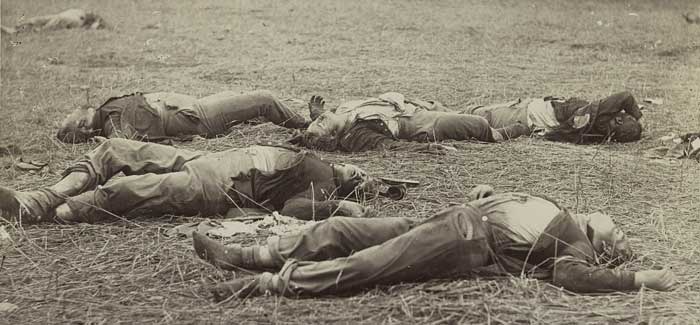
Here were confused heaps of dead men, Federal and
Confederate, lying mingled as they fell fighting one another.
Feeling my way among them I found three or
four lying close together, side by side, at their feet another body, at
their
heads two more. One poor fellow had evidently struggled a moment for
life after
receiving his mortal wound, then, pillowing his head on the breast of a
dead
comrade, lay passive as Death swept his dark wings over the
plain.
Judging from the position of some other
bodies I stumbled over a few paces beyond, a fearful shower of grape
and
canister must have torn the ranks of a regiment into shreds; for fifty
or
sixty bodies lay in a row, some on their faces, others on their backs,
while
the attitudes of a few betrayed the agony endured before death ended
their
sufferings. Though these could be but
dimly
seen in the darkness, I fancied the glazed eyes of the dead were
leering at
me. Leaving the sleeping battalion, I
came across the corpse of a little drummer-boy, who lay with his arms
still
clasped around his drum, his head shattered by a shell. Brave
boy! he had beaten his last rataplan. Now the scabbard of a
sword
jingled as my
uncertain foot struck it, the wearer being in a sitting posture, his
legs
shattered by a round shot.
Death! Death everywhere, in all its
horrid, awful forms! The swift bullet and
the cruel shell both had
been at work; and I realized what a price is paid for victories.
Still, I could not find my picket-post,
and was wholly
ignorant of my whereabouts; for now I came to the scene of another
desperate,
bloody struggle, the bodies rapidly accumulating under my feet, as they
lay in
confused masses on the grass. Tumbling
over one of these ghastly mounds of half-rotten flesh, I was startled
at
finding a human hand thrust into my face. For
a moment I imagined I had found a living man
amidst the dead, but on
closer scrutiny I saw the hand was a lifeless one. The
soldier’s
death had been so
instantaneous, that, as he fell with outstretched arm, the muscles
became rigid,
the stiffening fingers remaining poised in death, pointing to the
heavens
whither the sprit had taken flight. The
man’s musket lay across his chest ; and, putting my hand on the weapon,
I found
it still clutched by the dead owner.
Half mad, with a
feeling of fear tugging at my
heart-strings, I dashed wildly from the spot, and, stumbling and
falling, continued
my career over the encumbered field.
Yet I did not escape the presence of
the dead; for, as I
subsequently discovered, I was going round and round, like a man
entangled in
the depths of a forest. Owing to the
darkness, I imagined I had traveled a mile, though in reality I did not
leave
the vicinity of the glen. Besides the
bodies, my feet encountered muskets and knapsacks in extraordinary
confusion;
and once I narrowly escaped a fall over the distended carcass of a
horse,
killed perhaps while his rider was bravely cheering on his men, or
trying to
restore order in a broken line. Next my knee struck an exploded
caisson, and a
moment after I ran full tilt against dismantled cannon. Round
the
piece there had been an awful
combat, for the sod was thickly covered with the dead.
Utterly
exhausted by my unavailing efforts to
extricate myself from this mass of mouldering corpses, I determined to
halt
where I was.
“I’ll go no farther,” I
cried. “If I must lodge with the slain,
I’ll do it here.”
Seating myself on the broken
field-piece, I waited
impatiently for the dawn that was to drive away these wild fancies and
restore
me to my men. But the darkness still
held my senses enthralled; and, as I threw myself on the disabled
cannon, I
fancied that weird arms were pointing with shriveled fingers at the
living,
shrinking man in their midst. Try as I
would, I could not shake off the feeling that uncanny shapes were
abroad; and I
fell more and more under the influence of these ghostly fears, despite
my
better reason. The exciting duty I had performed since reaching the
field of Gettysburg
had so affected
my nervous system that these hallucinations seemed dread reality ……
Nearly two hundred thousand men were
sleeping around me,
while I was sitting wakeful and alone among the dead.
When I began hoping that the day would soon break,
strange
lights appeared in the distance, disappearing as soon as
seen.
Supposing them to be carried by
ambulance-parties
in search of wounded I rose to meet them. But
before I had taken many steps, I was surprised
to see one of these
mysterious lights quite near me, though there were no footsteps, no
voices. The flame grew brighter and
brighter, and then suddenly expired. Then
the truth flashed upon my mind; the light was
caused by the
mephitic gases escaping from putrefying corpses.
“Help – help – water – water!”
These words were uttered a little way
off, in a moaning
voice ; and when I heard them I knew some wounded wretch needed succor.
With a
feeling of relief at the presence of some human life among the dead, I
hastened
towards the sounds.
“Water – water! - My God! – is there no
help! – Water – a
little – wa-ter!”
The faint and weary cry was almost at
my feet. Dropping on my hands and knees, I
crawled
cautiously forward.
“Where are you? I
bring you water,” I cried cheerily, my nerves now firm as steel.
“Here,” said the voice more
faintly.
In a moment I was at the man’s side,
finding him in the midst
of a group of the dead.
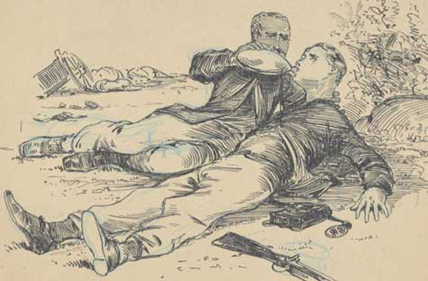 “Here you are,” said I,
unslinging my canteen and holding it to his lips.
“Here you are,” said I,
unslinging my canteen and holding it to his lips.
“But don’t drink too fast.”
The wounded man clutched the vessel,
and soon I heard the
water gurgling down his throat; when he stopped for breath I took the
canteen
from him, fearing if he drank too much it would kill him. …….
“Say, friend, I feel very weak. Am I
going
to die? Oh,
say I am not dying !” and the wretched
man’s voice quivered with
agony as he asked the question.
“I hope not, my man. Keep quiet
now.
It
will soon be daylight.”
“All right,” he replied,
resting
his head on a corpse behind him.
By this time the first faint streaks of daylight
began
stealing over the field, enabling me to distinguish objects at a little
distance. Still kneeling beside my new found charge, I watched the
trees and
rocks reveal their outlines. Next the corpses of men and horses, the
broken
cannon, the scattered muskets, all the debris
of the battle, became visible in their rude deformity and
confusion.
Little by little the light grew stronger,
until my whereabouts could be ascertained. I
then found I had unwittingly moved to the right of
our line, and so
wandered in a circle scarcely a thousand yards from my little
party.
Looking across the open plain, I could
see the ground thickly
strewn with the dead, the result of the Confederates' mad but heroic
charge.
In rifts like new mown grass in the hay-field,
lay long lines of slain men; while here and there were confused heaps
of
corpses, as though Death, the reaper, had already begun to reckon up
and garner
his harvest. Everywhere, on either hand,
before and behind me, was death, - death in all its diversity of form.
Averting my eyes from this broad
expanse of slaughtered men,
I turned my attention to the wounded one before me. Alas!
Death
had added another victim to the long
list to be made upon that bloody field; for he had expired, silently,
peacefully while asleep. If I had been
too late to save him, I had at least the consolation of knowing that I
had
soothed his last hour.
I should never know who he was; and
none of those who loved
him would know that in the silence of night, with his head pillowed on
a corpse,
his life had ebbed away.
“And this is the glory of war!” I
exclaimed, rising from my knees to join my command.
Next
Page: "The 3rd Days Fight"
Return
to Top
of Page | Continue
Reading
|

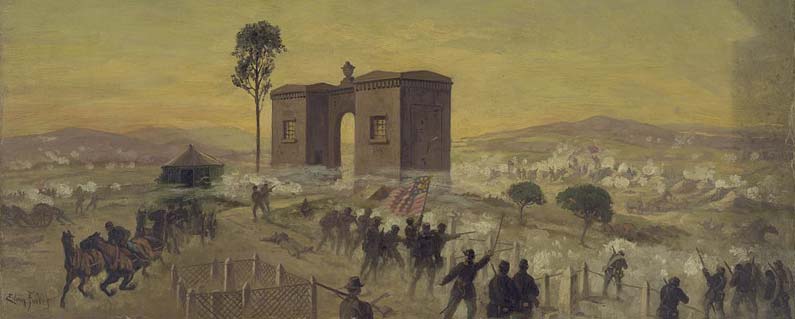


 Has our army been sufficiently reinforced?
is our
anxious question. A few minutes since we had a talk with an
officer of the staff of General Early, and he admits that our army has
the best position, but says we cannot hold it much longer.
The
Rebels do so much bragging that we do not know how much to
believe. At all events, the manner in which this officer
spoke
indicates that our troops have the advantage so far. Can they
keep it? The fear they may not be able causes our anxiety and
keeps us in suspense.
Has our army been sufficiently reinforced?
is our
anxious question. A few minutes since we had a talk with an
officer of the staff of General Early, and he admits that our army has
the best position, but says we cannot hold it much longer.
The
Rebels do so much bragging that we do not know how much to
believe. At all events, the manner in which this officer
spoke
indicates that our troops have the advantage so far. Can they
keep it? The fear they may not be able causes our anxiety and
keeps us in suspense.


































 They sat or stood as best pleased them or entered into a full
discussion of the questions of them. They defended slavery,
the
southern cause, etc., while we opposed them. They also talked
of
the events of the war. One, I remember, maintained that
General
Ewell worthily filled the place of “Stonewall” Jackson and also gave it
as his opinion that the latter was not killed by his own men but by our
troops. Two of the guards I also recollect got into an
altercation, and one threatened to shoot the other, but afterwards
calmed down. Indeed the temper of these men seemed to be more
violent and a disposition more to resort to extreme acts in settling
disputes than is customary with our more temperate people.
However, their treatment of us during our brief captivity was all that
could be desired. Nor were they at all rampant on the subject
of
their own prowess; they maintained a quiet but complete confidence that
they were to triumph in the battle.
They sat or stood as best pleased them or entered into a full
discussion of the questions of them. They defended slavery,
the
southern cause, etc., while we opposed them. They also talked
of
the events of the war. One, I remember, maintained that
General
Ewell worthily filled the place of “Stonewall” Jackson and also gave it
as his opinion that the latter was not killed by his own men but by our
troops. Two of the guards I also recollect got into an
altercation, and one threatened to shoot the other, but afterwards
calmed down. Indeed the temper of these men seemed to be more
violent and a disposition more to resort to extreme acts in settling
disputes than is customary with our more temperate people.
However, their treatment of us during our brief captivity was all that
could be desired. Nor were they at all rampant on the subject
of
their own prowess; they maintained a quiet but complete confidence that
they were to triumph in the battle.
 He
said with a smile, “If you
Yanks don’t wish to
get
shot, you hadn’t better travel that way any
farther.” We told
him
we wished to keep within our limits, and were sorry that we had passed
them. As he seemed inclined to talk, we felt to take the
liberty
to ask a few questions, and the first one was: “Where is the
union
army?” He laughed again and pointed to the hill, said “Look
there.” We looked in the direction he pointed, and there,
sure
enough, was the old stars and stripes waving in the morning sunlight,
with a battery its muzzles pointing directly at us. We said,
some
of your fellows told us last night that the union army were ten miles
away, [and] he said “he wished they were, but he thought the fellows
had not been where he was.” Thinking that the locality might
under certain conditions be extremely unhealthy, and not caring to stay
so near, or as we were outside their lines, we concluded not to stay
there longer and started to go back. We crossed the street
and
just then a reb came up with a barrel about half full of little
crackers; the crackers were an inch square. He turned them down on the
sidewalk and cried out as loud as he could yell, “Fall in for
rations.” The rebs jumped up from all around and came running
for
their share; other rebs were coming bringing barrels. As they
did
not extend the invitation to us, we thought it best not to help
ourselves, so we passed on.
He
said with a smile, “If you
Yanks don’t wish to
get
shot, you hadn’t better travel that way any
farther.” We told
him
we wished to keep within our limits, and were sorry that we had passed
them. As he seemed inclined to talk, we felt to take the
liberty
to ask a few questions, and the first one was: “Where is the
union
army?” He laughed again and pointed to the hill, said “Look
there.” We looked in the direction he pointed, and there,
sure
enough, was the old stars and stripes waving in the morning sunlight,
with a battery its muzzles pointing directly at us. We said,
some
of your fellows told us last night that the union army were ten miles
away, [and] he said “he wished they were, but he thought the fellows
had not been where he was.” Thinking that the locality might
under certain conditions be extremely unhealthy, and not caring to stay
so near, or as we were outside their lines, we concluded not to stay
there longer and started to go back. We crossed the street
and
just then a reb came up with a barrel about half full of little
crackers; the crackers were an inch square. He turned them down on the
sidewalk and cried out as loud as he could yell, “Fall in for
rations.” The rebs jumped up from all around and came running
for
their share; other rebs were coming bringing barrels. As they
did
not extend the invitation to us, we thought it best not to help
ourselves, so we passed on.


 We
at once
proceeded there, and soon after our arrival all the corps commanders
were assembled in the little front room of the Liester House – Newton,
who had been assigned to the command of the First Corps over Doubleday,
his senior; Hancock, Second; Birney, Third; Sykes, Fifth; Sedgwick, who
had arrived during the day with the Sixth, after a long march from
Manchester; Howard, Eleventh; and Slocum, Twelfth, besides General
Meade, General Butterfield, chief of staff; Warren, chief of engineers;
A.S. Williams, Twelfth Corps, and myself, Second. It will be
seen
that two corps were doubly represented, the Second by Hancock and
myself, and the Twelfth by Slocum and Williams. These twelve were all
assembled in a little room not more than ten or twelve feet square,
with a bed in one corner, a small table on one side, and a chair or
two. Of course all could not sit down; some did, some lounged
on
the bed, and some stood up, while Warren, tired out and suffering from
a wound in the neck, where piece of shell had
struck him,
lay down in the corner of the room and went sound asleep, and I don’t
think heard any of the proceedings.
We
at once
proceeded there, and soon after our arrival all the corps commanders
were assembled in the little front room of the Liester House – Newton,
who had been assigned to the command of the First Corps over Doubleday,
his senior; Hancock, Second; Birney, Third; Sykes, Fifth; Sedgwick, who
had arrived during the day with the Sixth, after a long march from
Manchester; Howard, Eleventh; and Slocum, Twelfth, besides General
Meade, General Butterfield, chief of staff; Warren, chief of engineers;
A.S. Williams, Twelfth Corps, and myself, Second. It will be
seen
that two corps were doubly represented, the Second by Hancock and
myself, and the Twelfth by Slocum and Williams. These twelve were all
assembled in a little room not more than ten or twelve feet square,
with a bed in one corner, a small table on one side, and a chair or
two. Of course all could not sit down; some did, some lounged
on
the bed, and some stood up, while Warren, tired out and suffering from
a wound in the neck, where piece of shell had
struck him,
lay down in the corner of the room and went sound asleep, and I don’t
think heard any of the proceedings.

 “Here you are,” said I,
unslinging my canteen and holding it to his lips.
“Here you are,” said I,
unslinging my canteen and holding it to his lips.